DNS Manager For WHMCS
(→About DNS Manager For WHMCS) |
|||
| Line 5: | Line 5: | ||
{| | {| | ||
|style="padding: 10px 0px 10px 0px;"|'''DNS Manager For WHMCS''' is fully featured addon module that allows your customers to manage their DNS zones.<br /> | |style="padding: 10px 0px 10px 0px;"|'''DNS Manager For WHMCS''' is fully featured addon module that allows your customers to manage their DNS zones.<br /> | ||
| − | + | A great choice of submodules together with options such as creating ready packages make DNS Manager for WHMCS perfectly adapt to your specific needs.<br /> | |
| − | As an administrator you have full control over DNS zones and | + | As an administrator you have full control over DNS zones and access to broad range of management options. |
|} | |} | ||
<!--a comment maybe? --> | <!--a comment maybe? --> | ||
| − | *'''DNS | + | *'''Admin Area Features:''' |
| + | {| | ||
| + | |style="padding: 10px 0px 0px 30px;"|✔ Define DNS Servers | ||
| + | |} | ||
| + | {| | ||
| + | |style="padding: 0px 0px 0px 30px;"|✔ Define Packages | ||
| + | |} | ||
| + | {| | ||
| + | |style="padding: 0px 0px 0px 30px;"|✔ View And Edit Existing Zones | ||
| + | |} | ||
| + | {| | ||
| + | |style="padding: 0px 0px 0px 30px;"|✔ Migrate Zones Between Chosen Servers | ||
| + | |} | ||
| + | {| | ||
| + | |style="padding: 0px 0px 0px 30px;"|✔ Import Zones From Chosen Server | ||
| + | |} | ||
| + | {| | ||
| + | |style="padding: 0px 0px 0px 30px;"|✔ Define DNS Records Set | ||
| + | |} | ||
| + | {| | ||
| + | |style="padding: 0px 0px 0px 30px;"|✔ Set Up Automated Tasks And Execution Time | ||
| + | |} | ||
| + | {| | ||
| + | |style="padding: 0px 0px 0px 30px;"|✔ Select Default Client Area Template | ||
| + | |} | ||
| + | {| | ||
| + | |style="padding: 0px 0px 0px 30px;"|✔ Toggle Administrator Notifications And Choose Who Send Them To | ||
| + | |} | ||
| + | {| | ||
| + | |style="padding: 0px 0px 0px 30px;"|✔ Modify Notifications Email Templates | ||
| + | |} | ||
| + | {| | ||
| + | |style="padding: 0px 0px 0px 30px;"|✔ Define Logs And Notifications Settings | ||
| + | |} | ||
| + | {| | ||
| + | |style="padding: 0px 0px 0px 30px;"|✔ View Details And Notifications Related To Zones And Servers Load | ||
| + | |} | ||
| + | {| | ||
| + | |style="padding: 0px 0px 0px 30px;"|✔ View Information About Automated Tasks | ||
| + | |} | ||
| + | {| | ||
| + | |style="padding: 0px 0px 0px 30px;"|✔ View Scheduled Tasks Progress | ||
| + | |} | ||
| + | {| | ||
| + | |style="padding: 0px 0px 0px 30px;"|✔ Display Usage Of DNS Servers | ||
| + | |} | ||
| + | {| | ||
| + | |style="padding: 0px 0px 0px 30px;"|✔ View Email Notifications Statistics | ||
| + | |} | ||
| + | {| | ||
| + | |style="padding: 0px 0px 10px 30px;"|✔ View Logs | ||
| + | |} | ||
| + | *'''Client Area Features:''' | ||
| + | {| | ||
| + | |style="padding: 10px 0px 0px 30px;"|✔ View List Of Owned Packages | ||
| + | |} | ||
| + | {| | ||
| + | |style="padding: 0px 0px 0px 30px;"|✔ Add And Manage New Zones Within Package Limit | ||
| + | |} | ||
| + | {| | ||
| + | |style="padding: 0px 0px 0px 30px;"|✔ Add And Manage Zones Records Within Records Limits | ||
| + | |} | ||
| + | {| | ||
| + | |style="padding: 0px 0px 0px 30px;"|✔ Restore Zone From DNS Records Set | ||
| + | |} | ||
| + | {| | ||
| + | |style="padding: 0px 0px 0px 30px;"|✔ View Zones Limit Per Package | ||
| + | |} | ||
| + | {| | ||
| + | |style="padding: 0px 0px 10px 30px;"|✔ View DNS Records Limits Per Zone | ||
| + | |} | ||
| + | |||
| + | *'''Automation Features:''' | ||
| + | {| | ||
| + | |style="padding: 10px 0px 0px 30px;"|✔ Provision Packages | ||
| + | |} | ||
| + | {| | ||
| + | |style="padding: 0px 0px 0px 30px;"|✔ Migrate Zones | ||
| + | |} | ||
| + | {| | ||
| + | |style="padding: 0px 0px 0px 30px;"|✔ Import Zones | ||
| + | |} | ||
| + | {| | ||
| + | |style="padding: 0px 0px 0px 30px;"|✔ Clear Unused Zones | ||
| + | |} | ||
| + | {| | ||
| + | |style="padding: 0px 0px 10px 30px;"|✔ Clear Logs | ||
| + | |} | ||
| + | |||
| + | *'''Server Settings:''' | ||
| + | {| | ||
| + | |style="padding: 10px 0px 0px 30px;"|✔ Allow rDNS | ||
| + | |} | ||
| + | {| | ||
| + | |style="padding: 0px 0px 0px 30px;"|✔ Allow Multiple PTR | ||
| + | |} | ||
| + | {| | ||
| + | |style="padding: 0px 0px 0px 30px;"|✔ Use Cache To Optimize Loading Time | ||
| + | |} | ||
| + | {| | ||
| + | |style="padding: 0px 0px 10px 30px;"|✔ Define Nameservers | ||
| + | |} | ||
| + | |||
| + | *'''Package Settings:''' | ||
| + | {| | ||
| + | |style="padding: 10px 0px 0px 30px;"|✔ Define Zones Limit Per Package | ||
| + | |} | ||
| + | {| | ||
| + | |style="padding: 0px 0px 0px 30px;"|✔ Define Items (Products/Domains/Products Addons) Purchase Of Which Results In Receiving Package | ||
| + | |} | ||
| + | {| | ||
| + | |style="padding: 0px 0px 0px 30px;"|✔ Define Servers Used By Package | ||
| + | |} | ||
| + | {| | ||
| + | |style="padding: 0px 0px 0px 30px;"|✔ Define Allowed Record Types | ||
| + | |} | ||
| + | {| | ||
| + | |style="padding: 0px 0px 0px 30px;"|✔ Define Total Records Limit | ||
| + | |} | ||
| + | {| | ||
| + | |style="padding: 0px 0px 0px 30px;"|✔ Define Record Limits Per Type | ||
| + | |} | ||
| + | {| | ||
| + | |style="padding: 0px 0px 0px 30px;"|✔ Define Automation Settings For Creating First Zone | ||
| + | |} | ||
| + | {| | ||
| + | |style="padding: 0px 0px 0px 30px;"|✔ Assign Default DNS Records Set | ||
| + | |} | ||
| + | {| | ||
| + | |style="padding: 0px 0px 0px 30px;"|✔ Allow Client To Restore Zone Using Chosen DNS Records Sets | ||
| + | |} | ||
| + | {| | ||
| + | |style="padding: 0px 0px 10px 30px;"|✔ Toggle Client And Administrator Notifications | ||
| + | |} | ||
| + | |||
| + | *'''Supported DNS Servers:''' | ||
{| | {| | ||
|style="padding: 10px 0px 0px 30px;"|✔ cPanel & cPanel DNSOnly | |style="padding: 10px 0px 0px 30px;"|✔ cPanel & cPanel DNSOnly | ||
| Line 67: | Line 202: | ||
|style="padding: 0px 0px 10px 30px;"|✔ DynDNS | |style="padding: 0px 0px 10px 30px;"|✔ DynDNS | ||
|} | |} | ||
| − | *'''DNS | + | |
| + | *'''Supported DNS Record Types:''' | ||
{| | {| | ||
| − | |style="padding: 10px 0px 0px 30px;"|✔ | + | |style="padding: 10px 0px 0px 30px;"|✔ A |
|} | |} | ||
{| | {| | ||
| − | |style="padding: 0px 0px 0px 30px;"|✔ | + | |style="padding: 0px 0px 0px 30px;"|✔ AAAA |
|} | |} | ||
{| | {| | ||
| − | |style="padding: 0px 0px 0px 30px;"|✔ | + | |style="padding: 0px 0px 0px 30px;"|✔ AFSDB |
|} | |} | ||
{| | {| | ||
| − | |style="padding: 0px 0px 0px 30px;"|✔ | + | |style="padding: 0px 0px 0px 30px;"|✔ CNAME |
|} | |} | ||
{| | {| | ||
| − | |style="padding: 0px 0px 0px 30px;"|✔ | + | |style="padding: 0px 0px 0px 30px;"|✔ DNAME |
|} | |} | ||
{| | {| | ||
| − | |style="padding: 0px 0px 0px 30px;"|✔ | + | |style="padding: 0px 0px 0px 30px;"|✔ DS |
|} | |} | ||
{| | {| | ||
| − | |style="padding: 0px 0px 0px 30px;"|✔ | + | |style="padding: 0px 0px 0px 30px;"|✔ HINFO |
|} | |} | ||
{| | {| | ||
| − | |style="padding: 0px 0px 0px 30px;"|✔ | + | |style="padding: 0px 0px 0px 30px;"|✔ ISDN |
|} | |} | ||
{| | {| | ||
| − | |style="padding: 0px 0px 0px 30px;"|✔ | + | |style="padding: 0px 0px 0px 30px;"|✔ LOC |
|} | |} | ||
{| | {| | ||
| − | |style="padding: 0px 0px 0px 30px;"|✔ | + | |style="padding: 0px 0px 0px 30px;"|✔ MB |
|} | |} | ||
{| | {| | ||
| − | |style="padding: 0px 0px 0px 30px;"|✔ | + | |style="padding: 0px 0px 0px 30px;"|✔ MD |
|} | |} | ||
{| | {| | ||
| − | |style="padding: 0px 0px 0px 30px;"|✔ | + | |style="padding: 0px 0px 0px 30px;"|✔ MF |
|} | |} | ||
{| | {| | ||
| − | |style="padding: 0px 0px 0px 30px;"|✔ | + | |style="padding: 0px 0px 0px 30px;"|✔ MG |
|} | |} | ||
{| | {| | ||
| − | |style="padding: 0px 0px 0px 30px;"|✔ | + | |style="padding: 0px 0px 0px 30px;"|✔ MINFO |
|} | |} | ||
{| | {| | ||
| − | |style="padding: 0px 0px 0px 30px;"|✔ | + | |style="padding: 0px 0px 0px 30px;"|✔ MR |
|} | |} | ||
{| | {| | ||
| − | |style="padding: 0px 0px 0px 30px;"|✔ | + | |style="padding: 0px 0px 0px 30px;"|✔ MX |
|} | |} | ||
{| | {| | ||
| − | |style="padding: 0px 0px 0px 30px;"|✔ | + | |style="padding: 0px 0px 0px 30px;"|✔ NAPTR |
|} | |} | ||
{| | {| | ||
| − | |style="padding: 0px 0px 0px 30px;"|✔ | + | |style="padding: 0px 0px 0px 30px;"|✔ NS |
|} | |} | ||
{| | {| | ||
| − | |style="padding: 0px 0px 0px 30px;"|✔ | + | |style="padding: 0px 0px 0px 30px;"|✔ PTR |
|} | |} | ||
{| | {| | ||
| − | |style="padding: 0px 0px 0px 30px;"|✔ | + | |style="padding: 0px 0px 0px 30px;"|✔ RP |
|} | |} | ||
{| | {| | ||
| − | |style="padding: 0px 0px 0px 30px;"|✔ | + | |style="padding: 0px 0px 0px 30px;"|✔ SOA |
|} | |} | ||
{| | {| | ||
| − | |style="padding: 0px 0px 0px 30px;"|✔ | + | |style="padding: 0px 0px 0px 30px;"|✔ SRV |
|} | |} | ||
{| | {| | ||
| − | |style="padding: 0px 0px | + | |style="padding: 0px 0px 0px 30px;"|✔ TXT |
|} | |} | ||
| + | {| | ||
| + | |style="padding: 0px 0px 0px 30px;"|✔ WKS | ||
| + | |} | ||
| + | {| | ||
| + | |style="padding: 0px 0px 10px 30px;"|✔ X25 | ||
| + | |} | ||
| + | |||
*'''General Info:''' | *'''General Info:''' | ||
{| | {| | ||
| − | |style="padding: 10px 0px 0px 30px;"|✔ | + | |style="padding: 10px 0px 0px 30px;"|✔ IDN Zones Supported |
| + | |} | ||
| + | {| | ||
| + | |style="padding: 0px 0px 0px 30px;"|✔ Template Customization Support | ||
|} | |} | ||
{| | {| | ||
| − | |style="padding: 0px 0px 0px 30px;"|✔ Multi-Language Support | + | |style="padding: 0px 0px 0px 30px;"|✔ Multi-Language Support |
|} | |} | ||
{| | {| | ||
| Line 157: | Line 303: | ||
|} | |} | ||
{| | {| | ||
| − | |style="padding: 10px 0px 20px 15px;"|'''1. Log in to your client area and download DNS Manager.''' | + | |style="padding: 10px 0px 20px 15px;"|'''1. Log in to your client area and download DNS Manager For WHMCS.''' |
|} | |} | ||
{| | {| | ||
| − | |style="padding: 0px 0px 20px 25px;"|[[File: | + | |style="padding: 0px 0px 20px 25px;"|[[File:DNS2_1.png]] |
|} | |} | ||
{| | {| | ||
| Line 166: | Line 312: | ||
|} | |} | ||
{| | {| | ||
| − | |style="padding: 0px 0px 20px 15px;"|Files in your WHMCS directory should look like | + | |style="padding: 0px 0px 20px 15px;"|Files in your WHMCS directory should look like these. |
|} | |} | ||
{| | {| | ||
| − | |style="padding: 0px 0px 20px 25px;"|[[File: | + | |style="padding: 0px 0px 20px 25px;"|[[File:DNS2_2.png]] |
|} | |} | ||
{| | {| | ||
| Line 186: | Line 332: | ||
|} | |} | ||
{| | {| | ||
| − | |style="padding: 0px 0px 15px 15px;"|'''5. | + | |style="padding: 0px 0px 15px 15px;"|<span style="color: red">'''5. This steps is required only if you are using WHMCS V5.x.x'''</span> |
| − | + | Open your currently used template: ''yourWHMCS → Templates → Default → header.tpl''<br/> | |
| + | |||
| + | Find line (66): | ||
| + | |||
| + | <nowiki><li class="divider"></li></nowiki> | ||
| + | |||
| + | Insert this code snippet above that line: | ||
| + | |||
| + | <nowiki><li><a href="index.php?m=DNSManager2">DNS Manager</a></li> </nowiki> | ||
| + | |||
| + | This is how it should look like: | ||
|} | |} | ||
{| | {| | ||
| − | |style="padding: 0px 0px | + | |style="padding: 0px 0px 15px 15px;"|[[File:DNS61.png]] |
|} | |} | ||
{| | {| | ||
| − | |style="padding: 0px 0px 15px 15px;"| | + | |style="padding: 0px 0px 15px 15px;"|'''Note! There is no integration required for WHMCS V6.x.x!''' |
| − | + | ||
| − | + | ||
| − | + | ||
| − | + | ||
| − | + | ||
| − | + | ||
| − | + | ||
| − | + | ||
| − | + | ||
| − | + | ||
| − | + | ||
| − | + | ||
| − | + | ||
| − | + | ||
| − | + | ||
| − | + | ||
| − | + | ||
| − | + | ||
| − | + | ||
| − | + | ||
| − | + | ||
| − | + | ||
| − | + | ||
| − | + | ||
| − | + | ||
|} | |} | ||
{| | {| | ||
| Line 226: | Line 357: | ||
|} | |} | ||
{| | {| | ||
| − | |style="padding: 0px 0px 20px 25px;"|[[File: | + | |style="padding: 0px 0px 20px 25px;"|[[File:DNS2_3.png]] |
|} | |} | ||
{| | {| | ||
| Line 232: | Line 363: | ||
|} | |} | ||
{| | {| | ||
| − | |style="padding: 0px 0px 20px 25px;"|[[File: | + | |style="padding: 0px 0px 20px 25px;"|[[File:DNS2_4.png]] |
|} | |} | ||
{| | {| | ||
| − | |style="padding: 0px 0px | + | |style="padding: 0px 0px 15px 15px;"|'''9. Good job! You have just successfully installed DNS Manager For WHMCS! Now in your WHMCS system press '' 'Addons' '' then press '' 'DNS Manager'. '' '''<br /> |
| + | You should see a following screen. | ||
|} | |} | ||
{| | {| | ||
| − | |style="padding: 0px 0px | + | |style="padding: 0px 0px 30px 25px;"|[[File:DNS2_6.png]] |
| − | + | ||
|} | |} | ||
| + | |||
| + | =Configuration and Management= | ||
{| | {| | ||
| − | |style="padding: 0px | + | |style="padding: 10px 0px 30px 15px;"|This section has been divided into two main parts to allow full and at the same time easy understanding of the whole module functionality.<br/>In the first part '' 'Basic Configuration' '' an exemplary flow of basic configuration of servers, through creating packages and then zones management<br/> from both the client and the administrator side has been presented.<br/> In the second part, there are described additional settings and tools that can be used while working with DNS Manager For WHMCS. |
|} | |} | ||
| + | ==Basic Configuration== | ||
{| | {| | ||
| − | |style="padding: | + | |style="padding: 10px 0px 15px 15px;"|In the first place we would like to show you the process of configuring your DNS manager on a simple example.<br/>Follow the steps below to see how the process looks like in practice.<br /> |
| − | + | Proceed to '' 'Addons' → 'DNS Manager'. '' There are several sections, but the one that you should be interested in the most in the beginning is '' 'Servers', '' you will find it under '' 'Settings' '' tab. | |
|} | |} | ||
{| | {| | ||
| − | |style="padding: 0px 0px | + | |style="padding: 0px 0px 30px 25px;"|[[File:DNS2_6.png]] |
|} | |} | ||
| + | |||
| + | ===Servers Configuration=== | ||
{| | {| | ||
| − | |style="padding: 0px | + | |style="padding: 10px 0px 15px 15px;"|To start your work, add a new server. |
|} | |} | ||
{| | {| | ||
| − | |style="padding: 0px 0px 20px | + | |style="padding: 0px 0px 20px 25px;"|[[File:DNS2_7.png]] |
|} | |} | ||
{| | {| | ||
| − | |style="padding: | + | |style="padding: 10px 0px 20px 15px;"|To add a new server you must fill our soma data to allow connection with it. As an example, we will try to connect with cPanel server.<br/>Additionally, you may declare here whether you need rDNS, Multiple PTR or Cashe. Select the chosen options. |
|} | |} | ||
{| | {| | ||
| − | |style="padding: 0px 0px 20px | + | |style="padding: 0px 0px 20px 25px;"|[[File:DNS2_8.png]] |
|} | |} | ||
{| | {| | ||
| − | |style="padding: 0px 0px 30px 25px;"|[[File: | + | |style="padding: 10px 0px 20px 15px;"|Once you have chosen a server from the dropdown menu, '' 'Configuration' '' and '' 'Nameservers' '' tabs appear.<br/>Enter your username, password, Hostname/IP and any other details needed to connect successfully.<br/> Now, press '' 'Nameservers' '' and enter the nameservers that will be visible for your customers in their client area. <br/> |
| + | <br/>Before you save the changes remember to test the connection. | ||
| + | |} | ||
| + | {| | ||
| + | |style="padding: 0px 0px 30px 25px;"|[[File:DNS2_9.png]] | ||
| + | |} | ||
| + | {| | ||
| + | |style="padding: 0px 0px 20px 15px;"|Now, that you have a ready server on the list of servers you may manage it. Turn it on/off, edit or delete. | ||
| + | |} | ||
| + | {| | ||
| + | |style="padding: 0px 0px 30px 25px;"|[[File:DNS2_10.png]] | ||
|} | |} | ||
| − | = | + | ===Management of Packages=== |
| − | == | + | |
{| | {| | ||
| − | |style="padding: 10px 0px 15px 15px;"| | + | |style="padding: 10px 0px 15px 15px;"|Packages - these are sets of products that will be sold and within which zones can be created by a client.<br/> '' 'Add' '' a new package to see how to configure it and what exactly you may specify there.<br /> |
| − | + | ||
| − | + | ||
| − | + | ||
| − | + | ||
|} | |} | ||
{| | {| | ||
| − | |style="padding: 0px 0px 20px 25px;"|[[File: | + | |style="padding: 0px 0px 20px 25px;"|[[File:DNS2_11.png]] |
|} | |} | ||
{| | {| | ||
| − | |style="padding: | + | |style="padding: 0px 0px 20px 15px;"|In general section you must obviously name the newly created package and define the number of owned zones per item ''(limit of zones that a client may then create within this package).''<br/> Here, you can also decide if zones should be created automatically after defined actions.<br/> These are: |
| + | *New Item | ||
| + | *Pending Transfer Domain | ||
| + | *Pending Registration Domain | ||
| + | *Domain with DNS Management | ||
|} | |} | ||
{| | {| | ||
| − | |style="padding: 0px 0px 30px 25px;"|[[File: | + | |style="padding: 0px 0px 30px 25px;"|[[File:DNS2_12.png]] |
| + | |} | ||
| + | ====Items==== | ||
| + | {| | ||
| + | |style="padding: 10px 0px 15px 15px;"|Assign Domains, Products or/and Product Addons from available to the package. | ||
| + | |} | ||
| + | {| | ||
| + | |style="padding: 0px 0px 30px 25px;"|[[File:DNS2_13.png]] | ||
|} | |} | ||
| − | == | + | ====Servers==== |
{| | {| | ||
| − | |style="padding: 10px 0px 15px 15px;"| | + | |style="padding: 10px 0px 15px 15px;"|Assign the package to the previously added server.<br/> |
| − | ''Note | + | ''Note! You may always assign the package to more than one server.'' |
|} | |} | ||
{| | {| | ||
| − | |style="padding: 0px 0px | + | |style="padding: 0px 0px 30px 25px;"|[[File:DNS2_14.png]] |
|} | |} | ||
| + | ====Record==== | ||
{| | {| | ||
| − | |style="padding: | + | |style="padding: 10px 0px 15px 15px;"|In this part you may define which type of records you want to allow, declare their limit and choose record sets. |
| − | + | ||
| − | + | ||
| − | + | ||
| − | + | ||
| − | + | ||
| − | + | ||
|} | |} | ||
{| | {| | ||
| − | |style="padding: 0px 0px | + | |style="padding: 0px 0px 30px 25px;"|[[File:DNS2_15.png]] |
|} | |} | ||
| + | |||
| + | ====Notification==== | ||
{| | {| | ||
| − | |style="padding: | + | |style="padding: 10px 0px 15px 15px;"|In the last part you may configure which notification will be sent to clients and administrators.<br/> Do not forget to '' 'Add' '' the newly configured package. |
| − | + | ||
| − | + | ||
|} | |} | ||
{| | {| | ||
| − | |style="padding: 0px 0px 20px 25px;"|[[File: | + | |style="padding: 0px 0px 20px 25px;"|[[File:DNS2_16.png]] |
|} | |} | ||
{| | {| | ||
| − | |style="padding: 0px 0px 15px 15px;"| | + | |style="padding: 0px 0px 15px 15px;"|Enable the newly created package to allow it to be used! |
| − | + | ||
| − | + | ||
|} | |} | ||
{| | {| | ||
| − | |style="padding: 0px 0px | + | |style="padding: 0px 0px 30px 25px;"|[[File:DNS2_17.png]] |
|} | |} | ||
| + | |||
| + | ===DNS Management in Client Area=== | ||
{| | {| | ||
| − | |style="padding: | + | |style="padding: 10px 0px 15px 15px;"|Now, that we already have the module configured you may see how clients will add and then manage their zones.<br/> In client area find button '' 'DNS Management' '' it will redirect you to the management page. |
| − | + | ||
|} | |} | ||
{| | {| | ||
| − | |style="padding: 0px 0px 20px 25px;"|[[File: | + | |style="padding: 0px 0px 20px 25px;"|[[File:DNS2_18.png]] |
|} | |} | ||
{| | {| | ||
| − | |style="padding: 0px 0px | + | |style="padding: 0px 0px 15px 15px;"|In here, clients may add new zones. To do so, simply type in the name of the zone and choose IP address from the available. |
|} | |} | ||
{| | {| | ||
| − | |style="padding: 0px 0px 20px 25px;"|[[File: | + | |style="padding: 0px 0px 20px 25px;"|[[File:DNS2_19.png]] |
|} | |} | ||
{| | {| | ||
| − | |style="padding: 0px 0px 20px | + | |style="padding: 0px 0px 20px 25px;"|[[File:DNS2_19_1.png]] |
|} | |} | ||
{| | {| | ||
| − | |style="padding: 0px 0px | + | |style="padding: 0px 0px 15px 15px;"|Allowed actions on a zone: |
| + | *edit existing zone (1) | ||
| + | *delete zone (2) | ||
| + | *create zone on the server (3) | ||
|} | |} | ||
| − | |||
| − | |||
{| | {| | ||
| − | |style="padding: | + | |style="padding: 0px 0px 20px 25px;"|[[File:DNS2_20.png]] |
| − | + | ||
| − | + | ||
| − | + | ||
|} | |} | ||
{| | {| | ||
| − | |style="padding: 0px 0px | + | |style="padding: 0px 0px 15px 15px;"|Press '' 'Edit' '' to see details of the zone, you may edit the zone here and add new records if limits allow you. |
|} | |} | ||
{| | {| | ||
| − | |style="padding: 0px 0px 20px | + | |style="padding: 0px 0px 20px 25px;"|[[File:DNS2_45.png]] |
|} | |} | ||
{| | {| | ||
| − | |style="padding: 0px 0px | + | |style="padding: 0px 0px 15px 15px;"|Enter new record's name, choose type from available etc. |
| + | |} | ||
| + | {| | ||
| + | |style="padding: 0px 0px 20px 25px;"|[[File:DNS2_46.png]] | ||
|} | |} | ||
| − | ==Management | + | ===Zones Management=== |
| + | {| | ||
| + | |style="padding: 10px 0px 20px 15px;"|In administrator panel, there are visible all clients' zones. As an admin, you will see whose zone it is, its type,<br/> on which server it is created and its status (created/deleted). | ||
| + | |} | ||
| + | {| | ||
| + | |style="padding: 0px 0px 20px 25px;"|[[File:DNS2_21.png]] | ||
| + | |} | ||
{| | {| | ||
| − | |style="padding: 10px 0px | + | |style="padding: 10px 0px 20px 15px;"|Actions on zones from the admin area: |
| − | + | *edit zone | |
| + | *synchronize | ||
| + | *create | ||
| + | *delete ''(zone is deleted both from WHMCS and from the server)'' | ||
| + | *remove from WHMCS ''(zone is still available on the server)'' | ||
|} | |} | ||
{| | {| | ||
| − | |style="padding: 0px 0px 30px 25px;"|[[File: | + | |style="padding: 0px 0px 30px 25px;"|[[File:DNS2_22.png]] |
|} | |} | ||
| − | == | + | ==Additional Tools== |
| + | ===DNS Records Sets=== | ||
{| | {| | ||
| − | |style="padding: 10px 0px | + | |style="padding: 10px 0px 15px 15px;"|Create ready made sets of DNS records. You will find them in '' 'Settings' → 'DNS Records Sets'. '' <br/>Press '' 'Add Set' '' to create a new one. |
|} | |} | ||
{| | {| | ||
| − | |style="padding: 0px 0px 20px 25px;"|[[File: | + | |style="padding: 0px 0px 20px 25px;"|[[File:DNS2_23.png]] |
|} | |} | ||
{| | {| | ||
| − | |style="padding: 10px 0px 20px 15px;"| | + | |style="padding: 10px 0px 20px 15px;"|Enter the newly created set name and then choose records from the dropdown menu, press '' '+'. '' |
|} | |} | ||
{| | {| | ||
| − | |style="padding: 0px 0px 20px 25px;"|[[File: | + | |style="padding: 0px 0px 20px 25px;"|[[File:DNS2_24.png]] |
|} | |} | ||
{| | {| | ||
| − | |style="padding: 0px 0px | + | |style="padding: 0px 0px 20px 15px;"|Now, fill out the data as required. |
| − | + | ||
|} | |} | ||
{| | {| | ||
| − | |style="padding: 0px 0px 20px 25px;"|[[File: | + | |style="padding: 0px 0px 20px 25px;"|[[File:DNS2_25.png]] |
|} | |} | ||
{| | {| | ||
| − | |style="padding: 0px 0px 20px 15px;"| | + | |style="padding: 0px 0px 20px 15px;"|Created DNS records Sets can be then used while preparing ready packages, as it was described. <br/>Ready made sets allow much faster and more personal configuration of packages. |
|} | |} | ||
{| | {| | ||
| − | |style="padding: 0px 0px | + | |style="padding: 0px 0px 20px 25px;"|[[File:DNS2_26.png]] |
|} | |} | ||
| − | == | + | ===Global Settings=== |
{| | {| | ||
| − | |style="padding: 10px 0px 15px 15px;"| | + | |style="padding: 10px 0px 15px 15px;"|This section has been designed to allow quick and simple configuration of global settings from one place. |
| − | + | ||
| − | + | ||
| − | + | ||
|} | |} | ||
{| | {| | ||
| − | |style="padding: 0px 0px | + | |style="padding: 0px 0px 30px 25px;"|[[File:DNS2_27.png]] |
|} | |} | ||
| + | ====Templates==== | ||
{| | {| | ||
| − | |style="padding: | + | |style="padding: 0px 0px 15px 15px;"|Choose a default template that will be used in client area.<br/> |
| + | If you have more than one template then you may allow your clients switch between them.<br/> | ||
| + | Decide whether you wish to use ready-configured redirection to DNS Management page in client area. | ||
|} | |} | ||
{| | {| | ||
| − | |style="padding: 0px 0px | + | |style="padding: 0px 0px 30px 25px;"|[[File:DNS2_28.png]] |
|} | |} | ||
| + | ====Notifications==== | ||
{| | {| | ||
| − | |style="padding: 0px 0px 20px 15px;"| | + | |style="padding: 0px 0px 20px 15px;"|In this part, set which notification should be sent to clients and which to administrator. Select the ones that interest you.<br/> |
| + | Press '' 'Modify' '' and you will be quickly redirected to the email template page where you can adjust it to your needs. | ||
|} | |} | ||
{| | {| | ||
| − | |style="padding: 0px 0px 20px 25px;"|[[File: | + | |style="padding: 0px 0px 20px 25px;"|[[File:DNS2_29.png]] |
|} | |} | ||
{| | {| | ||
| − | |style="padding: 0px 0px 20px 15px;"| | + | |style="padding: 0px 0px 20px 15px;"|Use '' 'Exclude' '' button to specify domains, products and addons that zones assigned to them will NOT be included in notifications. |
|} | |} | ||
{| | {| | ||
| − | |style="padding: 0px 0px 20px 25px;"|[[File: | + | |style="padding: 0px 0px 20px 25px;"|[[File:DNS2_30.png]] |
|} | |} | ||
{| | {| | ||
| − | |style="padding: 0px 0px 20px 15px;"| | + | |style="padding: 0px 0px 20px 15px;"|Use '' 'Include' '' button to specify to which admin users notifications will be sent to. |
|} | |} | ||
{| | {| | ||
| − | |style="padding: 0px 0px 30px 25px;"|[[File: | + | |style="padding: 0px 0px 30px 25px;"|[[File:DNS2_31.png]] |
|} | |} | ||
| − | + | ====Logs And Notifications==== | |
| − | == | + | |
{| | {| | ||
| − | |style="padding: | + | |style="padding: 0px 0px 15px 15px;"|In this part you may impose when log entries and notifications should be removed from the system database. <br/>If you wish you may also check option '' 'Log Successful Actions' '' to store all entries in logs ''(DNS Manager → Settings → Logs).'' |
| − | + | ||
|} | |} | ||
{| | {| | ||
| − | |style="padding: 0px 0px | + | |style="padding: 0px 0px 30px 25px;"|[[File:DNS2_32.png]] |
|} | |} | ||
| + | |||
| + | ===Cron Jobs=== | ||
{| | {| | ||
| − | |style="padding: 0px 0px 15px 15px;"| | + | |style="padding: 0px 0px 15px 15px;"|In order to manage your cron job tasks proceed to '' 'Tools' → 'Cron'. ''<br/>Here, you will find four information boxes, each one responsible for management of separate cron task.<br/> These are: migration, import, synchronization and cleaner. |
| − | + | ||
|} | |} | ||
{| | {| | ||
| − | |style="padding: 0px 0px | + | |style="padding: 0px 0px 30px 25px;"|[[File:DNS2_33.png]] |
|} | |} | ||
{| | {| | ||
| − | |style="padding: 0px 0px | + | |style="padding: 0px 0px 15px 15px;"|At the very top, there is an info box with general cron details, such as recommended time interval of cron execution (5 minutes is suggested),<br/> the last execution time and run time period. ''(Keep it as frequent as possible!)'' |
|} | |} | ||
{| | {| | ||
| − | |style="padding: 0px 0px 30px 25px;"|[[File: | + | |style="padding: 0px 0px 30px 25px;"|[[File:DNS2_34.png]] |
|} | |} | ||
| − | |||
| − | |||
{| | {| | ||
| − | |style="padding: | + | |style="padding: 0px 0px 15px 15px;"|'''Cron Migration''' - responsible for calling added tasks to migrate zones between servers. Choose interval and declare how many zones can be migrated during a single execution.<br/>'''Cron Importer''' - responsible for calling added task to import zones from an external server to WHMCS. Choose interval and declare how many zones can be imported during a single execution.<br/> '''Cron Synchronization''' - this cron job is responsible for regular synchronization of created zones. Choose interval and declare how many zones can be synchronized during a single execution.<br/> Select '' 'Recheck Zones' '' to control already synchronized zones. |
| − | + | ||
| − | + | ||
|} | |} | ||
{| | {| | ||
| − | |style="padding: 0px 0px | + | |style="padding: 0px 0px 30px 25px;"|[[File:DNS2_35.png]] |
|} | |} | ||
{| | {| | ||
| − | |style="padding: 0px 0px 15px 15px;"| | + | |style="padding: 0px 0px 15px 15px;"|'''Cron Cleaner''' - this option is a little bit more complex. Just like in case of other jobs, firstly choose interval and declare how many zones shall be cleared<br/> during a single execution. Then you may specify conditions of clearing zones and records. |
| − | + | Zones are removed: | |
| + | *if no longer matches with any package | ||
| + | *has not been modified for a specified period of time | ||
| + | *its domain is not found in WHOIS Lookup | ||
| + | *no records are included | ||
| + | PTR Records are removed: | ||
| + | *if service is terminated or canceled | ||
|} | |} | ||
{| | {| | ||
| − | |style="padding: 0px 0px | + | |style="padding: 0px 0px 30px 25px;"|[[File:DNS2_36.png]] |
|} | |} | ||
| + | ===Import=== | ||
{| | {| | ||
| − | |style="padding: 0px 0px 15px 15px;"| | + | |style="padding: 0px 0px 15px 15px;"|Import - this is an additional tool that allows import of zones that exist on outside servers to WHMCS.<br/> Move to '' Tools' → 'Import' '' in your admin panel. You will find here a list of Import assignments with information on which server they are imported from,<br/> total number of already imported zones and the number of all zones, progress of import task. |
| − | + | ||
|} | |} | ||
{| | {| | ||
| − | |style="padding: 0px 0px 20px 25px;"|[[File: | + | |style="padding: 0px 0px 20px 25px;"|[[File:DNS2_37.png]] |
|} | |} | ||
{| | {| | ||
| − | |style="padding: 0px 0px 20px 15px;"| | + | |style="padding: 0px 0px 20px 15px;"|To add a new import task press add '' 'Import' ''' and choose server from which you need to import zones. |
|} | |} | ||
{| | {| | ||
| − | |style="padding: 0px 0px 20px 25px;"|[[File: | + | |style="padding: 0px 0px 20px 25px;"|[[File:DNS2_38.png]] |
|} | |} | ||
{| | {| | ||
| − | |style="padding: 0px 0px 20px 15px;"|Now | + | |style="padding: 0px 0px 20px 15px;"|Now, when the new import task appeared on the list of awaiting imports, you may schedule the manual import, cancel the task.<br/>When already scheduled, preview the list of imported zones to assign a client and a related product to the zone. |
|} | |} | ||
{| | {| | ||
| − | |style="padding: 0px 0px 30px 25px;"|[[File: | + | |style="padding: 0px 0px 30px 25px;"|[[File:DNS2_39.png]] |
|} | |} | ||
| − | |||
| − | |||
{| | {| | ||
| − | |style="padding: | + | |style="padding: 0px 0px 30px 15px;"|If you do not schedule the task, import will be triggered by a default cron job. |
| − | + | ||
| − | + | ||
| − | + | ||
|} | |} | ||
| + | |||
| + | ===Migration=== | ||
{| | {| | ||
| − | |style="padding: 0px 0px | + | |style="padding: 0px 0px 15px 15px;"|'' 'Migration' '' is another useful tool that you may use to manage zones efficiently. With this tool you may migrate zones between servers. <br/> |
| + | Keep in mind, that when you are migrating zones from one server to another they are not imported to your WHMCS in the meantime!<br/> If you wish to update the list of migrated zones, you will have to import them to WHMCS from the final server after migration.<br/> | ||
| + | <br/> | ||
| + | Remember that migrated zones are available on both servers now! Migration does not delete zones just copy them to the new server! | ||
|} | |} | ||
{| | {| | ||
| − | |style="padding: 0px 0px 20px | + | |style="padding: 0px 0px 20px 25px;"|[[File:DNS2_40.png]] |
|} | |} | ||
{| | {| | ||
| − | |style="padding: 0px 0px | + | |style="padding: 0px 0px 20px 15px;"|To add migration task, press '' 'Add migration', '' specify from which server you wish to migrate zones, and the target server, as simple as that.<br/> |
| + | Note! Migration does not copy DNS Manager settings, to illustrate: if you are migrating zones that exits in DNS Manager their locations for example are not updated. | ||
|} | |} | ||
| − | |||
| − | |||
{| | {| | ||
| − | |style="padding: | + | |style="padding: 0px 0px 30px 25px;"|[[File:DNS2_41.png]] |
| − | + | ||
|} | |} | ||
| + | ===Tasks=== | ||
{| | {| | ||
| − | |style="padding: 0px 0px | + | |style="padding: 0px 0px 15px 15px;"|You will find a list of current tasks in '' 'Tools' → 'Tasks' '' section.<br/> Among all tasks there are import tasks, migration and synchronization tasks. |
|} | |} | ||
{| | {| | ||
| − | |style="padding: 0px 0px | + | |style="padding: 0px 0px 30px 25px;"|[[File:DNS2_42.png]] |
|} | |} | ||
{| | {| | ||
| − | |style="padding: 0px 0px | + | |style="padding: 0px 0px 10px 15px;"|According to specifically set-up cron jobs all created tasks are regularly executed. Here, you can see current status of each task.<br/> If it is queuing for the next cron run, is currently executed, aborted or complete. Check when they were executed for the last time ''(Last Execution)'' and when the task was added. <br/>Available actions: call execution manually and remove the task. |
|} | |} | ||
| − | ==Integration Codes== | + | ==Dashboard== |
| + | {| | ||
| + | |style="padding: 10px 0px 15px 15px;"|Home page of DNS Manager which can be used to get a quick and clear preview on the crucial parts of the module: added servers with number of zones created on them,<br/> summary of email messages sent to clients and finally the most important notifications. | ||
| + | |} | ||
| + | {| | ||
| + | |style="padding: 0px 0px 20px 25px;"|[[File:DNS2_43.png]] | ||
| + | |} | ||
| + | <!--==Integration Codes== | ||
{| | {| | ||
|style="padding: 10px 0px 15px 15px;"|With these codes you can easily change templates of your client area. You will find them in '' 'Configuration' '' → '' 'Integration Codes' '' section.<br /> | |style="padding: 10px 0px 15px 15px;"|With these codes you can easily change templates of your client area. You will find them in '' 'Configuration' '' → '' 'Integration Codes' '' section.<br /> | ||
| Line 526: | Line 692: | ||
|} | |} | ||
{| | {| | ||
| − | |style="padding: 0px 0px 30px 25px;"|[[File: | + | |style="padding: 0px 0px 30px 25px;"|[[File:DNS2_44.png]] |
|} | |} | ||
| + | --> | ||
| − | ==Client Area== | + | <!--==Client Area== |
{| | {| | ||
|style="padding: 10px 0px 30px 15px;"|Find out more about dns management in your client area. | |style="padding: 10px 0px 30px 15px;"|Find out more about dns management in your client area. | ||
| Line 538: | Line 705: | ||
|} | |} | ||
{| | {| | ||
| − | |style="padding: 0px 0px 20px 25px;"|[[File: | + | |style="padding: 0px 0px 20px 25px;"|[[File:DNS2_45.png]] |
|} | |} | ||
{| | {| | ||
| Line 544: | Line 711: | ||
|} | |} | ||
{| | {| | ||
| − | |style="padding: 0px 0px 20px 25px;"|[[File: | + | |style="padding: 0px 0px 20px 25px;"|[[File:DNS2_46.png]] |
|} | |} | ||
{| | {| | ||
| Line 551: | Line 718: | ||
|} | |} | ||
{| | {| | ||
| − | |style="padding: 0px 0px 20px 25px;"|[[File: | + | |style="padding: 0px 0px 20px 25px;"|[[File:DNS2_47.png]] |
|} | |} | ||
{| | {| | ||
| Line 557: | Line 724: | ||
|} | |} | ||
{| | {| | ||
| − | |style="padding: 0px 0px 30px 25px;"|[[File: | + | |style="padding: 0px 0px 30px 25px;"|[[File:DNS2_48.png]] |
|} | |} | ||
| Line 566: | Line 733: | ||
|} | |} | ||
{| | {| | ||
| − | |style="padding: 0px 0px 20px 25px;"|[[File: | + | |style="padding: 0px 0px 20px 25px;"|[[File:DNS2_49.png]] |
|} | |} | ||
{| | {| | ||
| Line 574: | Line 741: | ||
|} | |} | ||
{| | {| | ||
| − | |style="padding: 0px 0px 20px 25px;"|[[File: | + | |style="padding: 0px 0px 20px 25px;"|[[File:DNS2_50.png]] |
|} | |} | ||
{| | {| | ||
| Line 580: | Line 747: | ||
|} | |} | ||
{| | {| | ||
| − | |style="padding: 0px 0px 30px 25px;"|[[File: | + | |style="padding: 0px 0px 30px 25px;"|[[File:DNS2_51.png]] |
|} | |} | ||
| Line 588: | Line 755: | ||
|} | |} | ||
{| | {| | ||
| − | |style="padding: 0px 0px 20px 25px;"|[[File:DNS27. | + | |style="padding: 0px 0px 20px 25px;"|[[File:DNS27.2.png]] |
|} | |} | ||
{| | {| | ||
| Line 594: | Line 761: | ||
|} | |} | ||
{| | {| | ||
| − | |style="padding: 0px 0px 20px 25px;"|[[File:DNS28. | + | |style="padding: 0px 0px 20px 25px;"|[[File:DNS28.2.png]] |
|} | |} | ||
{| | {| | ||
| Line 600: | Line 767: | ||
|} | |} | ||
{| | {| | ||
| − | |style="padding: 0px 0px 20px 25px;"|[[File:DNS29. | + | |style="padding: 0px 0px 20px 25px;"|[[File:DNS29.2.png]] |
|} | |} | ||
{| | {| | ||
| Line 606: | Line 773: | ||
|} | |} | ||
{| | {| | ||
| − | |style="padding: 0px 0px 20px 25px;"|[[File:DNS30. | + | |style="padding: 0px 0px 20px 25px;"|[[File:DNS30.20.png]] |
|} | |} | ||
{| | {| | ||
| Line 612: | Line 779: | ||
|} | |} | ||
{| | {| | ||
| − | |style="padding: 0px 0px 30px 25px;"|[[File:DNS30. | + | |style="padding: 0px 0px 30px 25px;"|[[File:DNS30.20.png]] |
|} | |} | ||
| + | --> | ||
| + | <!-- | ||
==Template Switching In The Client Area== | ==Template Switching In The Client Area== | ||
{| | {| | ||
| Line 621: | Line 790: | ||
|} | |} | ||
{| | {| | ||
| − | |style="padding: 0px 0px 20px 25px;"|[[File:DNS51. | + | |style="padding: 0px 0px 20px 25px;"|[[File:DNS51.2.png]] |
|} | |} | ||
{| | {| | ||
| Line 628: | Line 797: | ||
|} | |} | ||
{| | {| | ||
| − | |style="padding: 0px 0px 20px 25px;"|[[File:DNS52. | + | |style="padding: 0px 0px 20px 25px;"|[[File:DNS52.2.png]] |
|} | |} | ||
{| | {| | ||
| Line 634: | Line 803: | ||
|} | |} | ||
{| | {| | ||
| − | |style="padding: 0px 0px 20px 25px;"|[[File:DNS53. | + | |style="padding: 0px 0px 20px 25px;"|[[File:DNS53.2.png]] |
|} | |} | ||
{| | {| | ||
| Line 640: | Line 809: | ||
|} | |} | ||
{| | {| | ||
| − | |style="padding: 0px 0px 30px 25px;"|[[File:DNS54. | + | |style="padding: 0px 0px 30px 25px;"|[[File:DNS54.2.png]] |
|} | |} | ||
| − | + | --> | |
==Custom cPanel Zone Templates== | ==Custom cPanel Zone Templates== | ||
{| | {| | ||
| Line 651: | Line 820: | ||
|} | |} | ||
{| | {| | ||
| − | |style="padding: 0px 0px 30px 25px;"|[[File: | + | |style="padding: 0px 0px 30px 25px;"|[[File:DNS2_55.2.png]] |
|} | |} | ||
==DNS Manager Logs== | ==DNS Manager Logs== | ||
{| | {| | ||
| − | |style="padding: 10px 0px 20px 15px;"|Logs help you keep track of all the activities carried out in DNS Manager. | + | |style="padding: 10px 0px 20px 15px;"|Logs help you keep track of all the activities carried out in DNS Manager. Find them here: '' 'Settings' → 'Logs'. '' |
|} | |} | ||
{| | {| | ||
| − | |style="padding: 0px 0px 30px 25px;"|[[File: | + | |style="padding: 0px 0px 30px 25px;"|[[File:DNS2_60.png]] |
|} | |} | ||
=Tips= | =Tips= | ||
{| | {| | ||
| − | |style="padding: 10px 0px 0px 15px;"|1. | + | |style="padding: 10px 0px 0px 15px;"|1. Keep track of your '' 'pending' '' and in '' 'progress' '' ''' 'Tasks' ''' to set an optimum interval time for the tasks execution. <br/> |
| + | For example, set interval in the way that half of the time task is set to pending status. | ||
|} | |} | ||
| + | <!-- | ||
{| | {| | ||
|style="padding: 5px 0px 0px 15px;"|2. When you set up processing to create zones with domains, the zones will be automatically created while ordering a new domain.<br /> | |style="padding: 5px 0px 0px 15px;"|2. When you set up processing to create zones with domains, the zones will be automatically created while ordering a new domain.<br /> | ||
| Line 699: | Line 870: | ||
|} | |} | ||
{| | {| | ||
| − | |style="padding: 0px 0px 30px 25px;"|[[File:DNS57. | + | |style="padding: 0px 0px 30px 25px;"|[[File:DNS57.2.png]] |
|} | |} | ||
| + | --> | ||
=Common Problems= | =Common Problems= | ||
| Line 707: | Line 879: | ||
|} | |} | ||
{| | {| | ||
| − | |style="padding: 0px 0px 0px 15px;"|2. If after successful installation in your client area you receive following or similar error: | + | |style="padding: 0px 0px 0px 15px;"|2. jQuery 1.9 is required to work properly. |
| + | |} | ||
| + | <!-- | ||
| + | If after successful installation in your client area you receive following or similar error: | ||
Fatal error: main() [function.require]: Failed opening required '/var/www/html/client/templates/dns_templates//lang/english.php'<br />(include_path='.:/usr/share/pear:/usr/share/php') in /var/www/html/client/templates/dns_templates/dns_controller.php on line 0 | Fatal error: main() [function.require]: Failed opening required '/var/www/html/client/templates/dns_templates//lang/english.php'<br />(include_path='.:/usr/share/pear:/usr/share/php') in /var/www/html/client/templates/dns_templates/dns_controller.php on line 0 | ||
That means that you have forgotten to configure and save processing of your addon. Tutorial on how to configure processing you can find [http://docs.modulesgarden.com/index.php?title=DNS_Manager_For_WHMCS#Configuration_of_processing here]<br /> | That means that you have forgotten to configure and save processing of your addon. Tutorial on how to configure processing you can find [http://docs.modulesgarden.com/index.php?title=DNS_Manager_For_WHMCS#Configuration_of_processing here]<br /> | ||
| Line 757: | Line 932: | ||
If you skip this step in the upgrade process the module will not work! Look at [http://www.docs.modulesgarden.com/DNS_Manager_For_WHMCS#Installation '''point 5'''] for more precise information. | If you skip this step in the upgrade process the module will not work! Look at [http://www.docs.modulesgarden.com/DNS_Manager_For_WHMCS#Installation '''point 5'''] for more precise information. | ||
|} | |} | ||
| + | --> | ||
Revision as of 20:03, 4 November 2015
Contents |
About DNS Manager For WHMCS
| DNS Manager For WHMCS is fully featured addon module that allows your customers to manage their DNS zones. A great choice of submodules together with options such as creating ready packages make DNS Manager for WHMCS perfectly adapt to your specific needs. |
- Admin Area Features:
| ✔ Define DNS Servers |
| ✔ Define Packages |
| ✔ View And Edit Existing Zones |
| ✔ Migrate Zones Between Chosen Servers |
| ✔ Import Zones From Chosen Server |
| ✔ Define DNS Records Set |
| ✔ Set Up Automated Tasks And Execution Time |
| ✔ Select Default Client Area Template |
| ✔ Toggle Administrator Notifications And Choose Who Send Them To |
| ✔ Modify Notifications Email Templates |
| ✔ Define Logs And Notifications Settings |
| ✔ View Details And Notifications Related To Zones And Servers Load |
| ✔ View Information About Automated Tasks |
| ✔ View Scheduled Tasks Progress |
| ✔ Display Usage Of DNS Servers |
| ✔ View Email Notifications Statistics |
| ✔ View Logs |
- Client Area Features:
| ✔ View List Of Owned Packages |
| ✔ Add And Manage New Zones Within Package Limit |
| ✔ Add And Manage Zones Records Within Records Limits |
| ✔ Restore Zone From DNS Records Set |
| ✔ View Zones Limit Per Package |
| ✔ View DNS Records Limits Per Zone |
- Automation Features:
| ✔ Provision Packages |
| ✔ Migrate Zones |
| ✔ Import Zones |
| ✔ Clear Unused Zones |
| ✔ Clear Logs |
- Server Settings:
| ✔ Allow rDNS |
| ✔ Allow Multiple PTR |
| ✔ Use Cache To Optimize Loading Time |
| ✔ Define Nameservers |
- Package Settings:
| ✔ Define Zones Limit Per Package |
| ✔ Define Items (Products/Domains/Products Addons) Purchase Of Which Results In Receiving Package |
| ✔ Define Servers Used By Package |
| ✔ Define Allowed Record Types |
| ✔ Define Total Records Limit |
| ✔ Define Record Limits Per Type |
| ✔ Define Automation Settings For Creating First Zone |
| ✔ Assign Default DNS Records Set |
| ✔ Allow Client To Restore Zone Using Chosen DNS Records Sets |
| ✔ Toggle Client And Administrator Notifications |
- Supported DNS Servers:
| ✔ cPanel & cPanel DNSOnly |
| ✔ Rage4 DNS |
| ✔ 4PSA |
| ✔ Storm On Demand |
| ✔ Zonomi |
| ✔ PowerDNS & PowerDNS Hosted |
| ✔ OpenSRS |
| ✔ Rackspace |
| ✔ DNS.com |
| ✔ SimpleDNS |
| ✔ DirectAdmin |
| ✔ RRPProxy Module |
| ✔ EuroDNS |
| ✔ Nettica |
| ✔ DNS Made Easy |
| ✔ Parallels Plesk |
| ✔ AtomiaDNS |
| ✔ Freenom |
| ✔ DynDNS |
- Supported DNS Record Types:
| ✔ A |
| ✔ AAAA |
| ✔ AFSDB |
| ✔ CNAME |
| ✔ DNAME |
| ✔ DS |
| ✔ HINFO |
| ✔ ISDN |
| ✔ LOC |
| ✔ MB |
| ✔ MD |
| ✔ MF |
| ✔ MG |
| ✔ MINFO |
| ✔ MR |
| ✔ MX |
| ✔ NAPTR |
| ✔ NS |
| ✔ PTR |
| ✔ RP |
| ✔ SOA |
| ✔ SRV |
| ✔ TXT |
| ✔ WKS |
| ✔ X25 |
- General Info:
| ✔ IDN Zones Supported |
| ✔ Template Customization Support |
| ✔ Multi-Language Support |
| ✔ Supports WHMCS Templates Five and Six |
| ✔ Supports WHMCS V5 and V6 |
Installation
| In this short tutorial we will show you how to successfully install DNS Manager For WHMCS. We will guide you step by step through the whole installation process. |
| 1. Log in to your client area and download DNS Manager For WHMCS. |
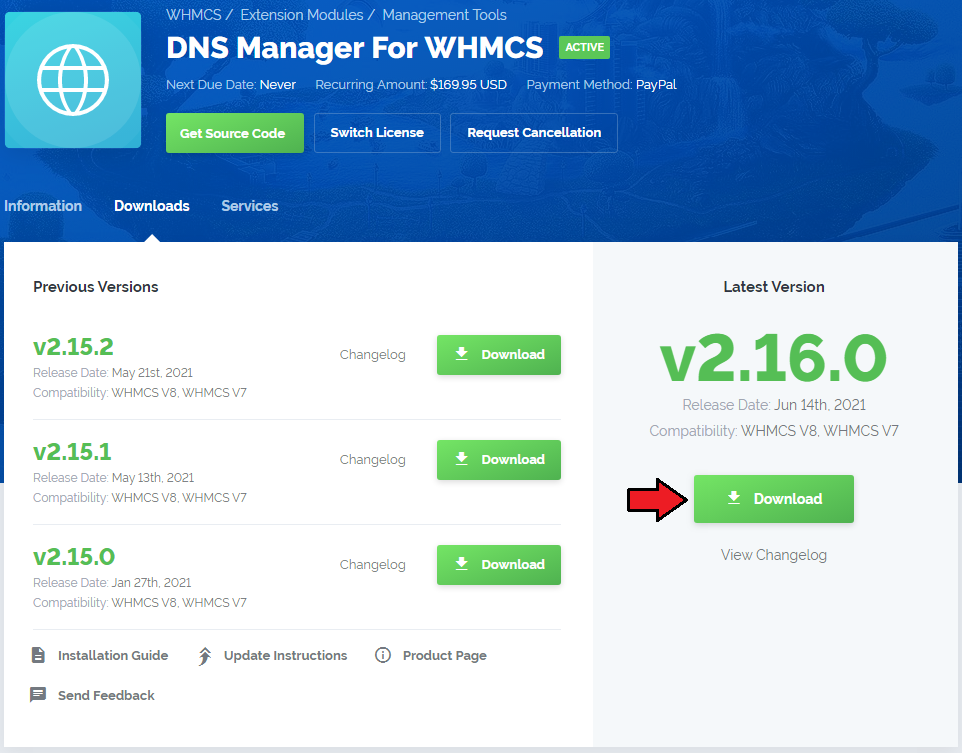
|
| 2. Upload and extract the module into the main WHMCS directory. |
| Files in your WHMCS directory should look like these. |

|
| 3. When you install DNS Manager for the first time you have to rename 'license_RENAME.php' file. File is located in 'modules/addons/dns_manager/license_RENAME.php.' Rename it from 'license_RENAME.php' to 'license.php'. |
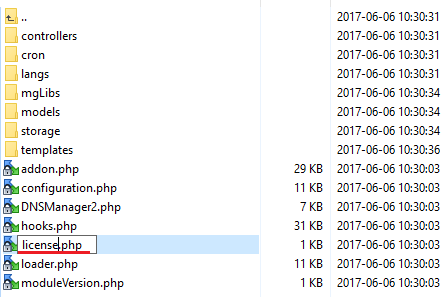
|
| 4. In order to configure your license key you have to edit a previously renamed 'license.php' file. Enter your licence key between quotation marks as presented on the following screen. You can find your license key in your client area → 'My Products'. |
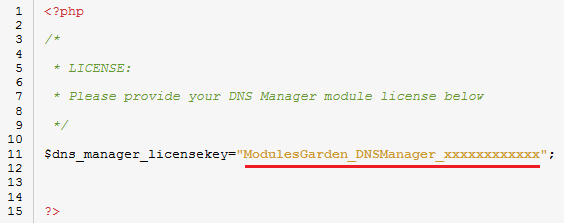
|
| 5. This steps is required only if you are using WHMCS V5.x.x
Open your currently used template: yourWHMCS → Templates → Default → header.tpl Find line (66): <li class="divider"></li> Insert this code snippet above that line: <li><a href="index.php?m=DNSManager2">DNS Manager</a></li> This is how it should look like: |
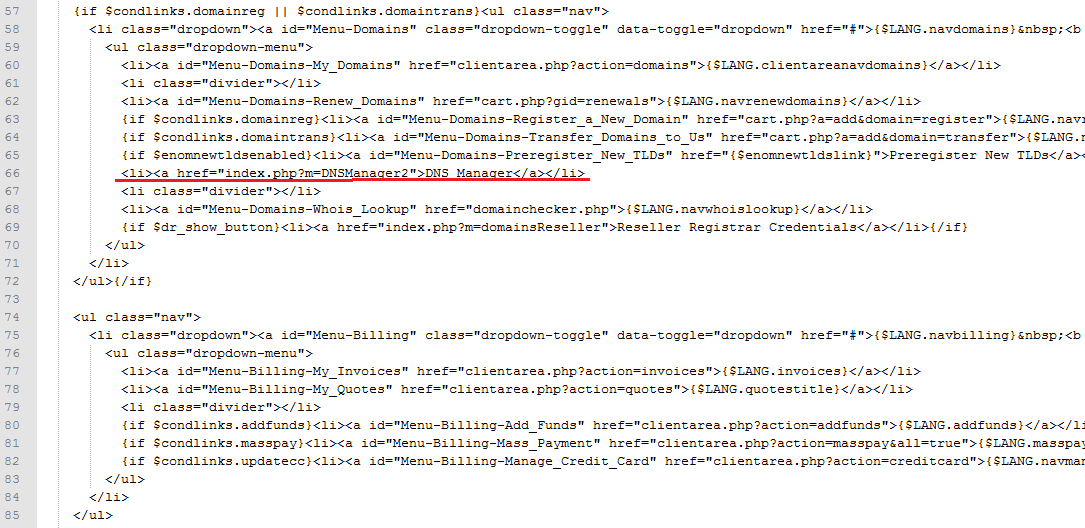
|
| Note! There is no integration required for WHMCS V6.x.x! |
| 6. Now you have to activate the module in your WHMCS system. Login to your WHMCS admin area. Click 'Setup' then choose 'Addon Modules'. |
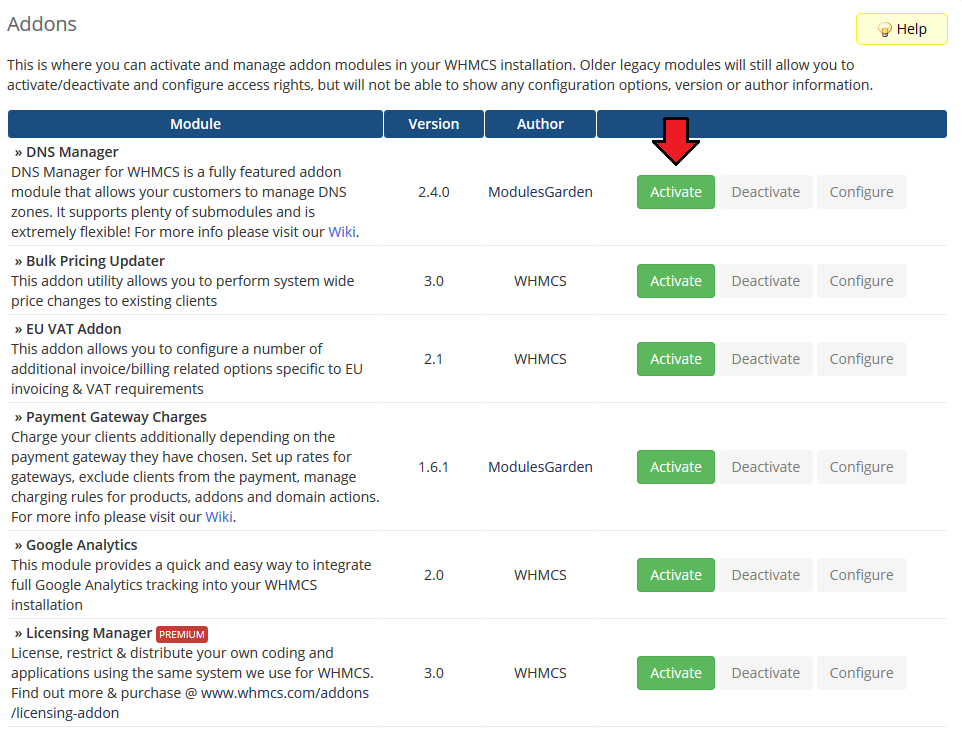
|
| 7. In next step you need to permit access to this module. To do so click on 'Configure' button, choose 'Full Administrator' and press 'Save Changes'. |
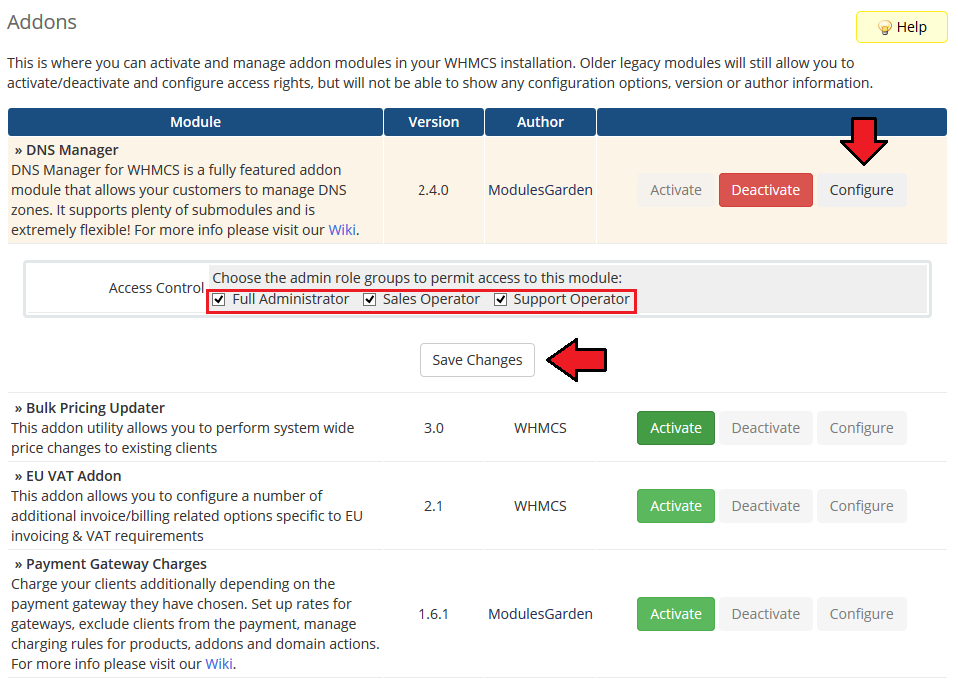
|
| 9. Good job! You have just successfully installed DNS Manager For WHMCS! Now in your WHMCS system press 'Addons' then press 'DNS Manager'. You should see a following screen. |
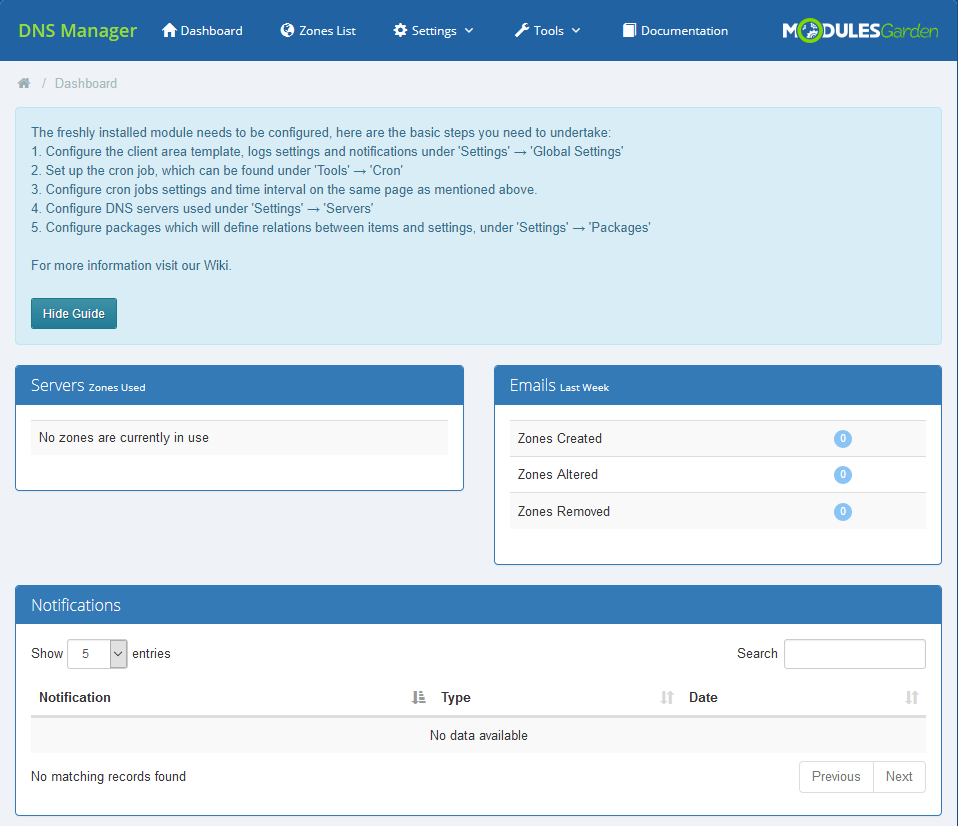
|
Configuration and Management
| This section has been divided into two main parts to allow full and at the same time easy understanding of the whole module functionality. In the first part 'Basic Configuration' an exemplary flow of basic configuration of servers, through creating packages and then zones management from both the client and the administrator side has been presented. In the second part, there are described additional settings and tools that can be used while working with DNS Manager For WHMCS. |
Basic Configuration
| In the first place we would like to show you the process of configuring your DNS manager on a simple example. Follow the steps below to see how the process looks like in practice. Proceed to 'Addons' → 'DNS Manager'. There are several sections, but the one that you should be interested in the most in the beginning is 'Servers', you will find it under 'Settings' tab. |

|
Servers Configuration
| To start your work, add a new server. |
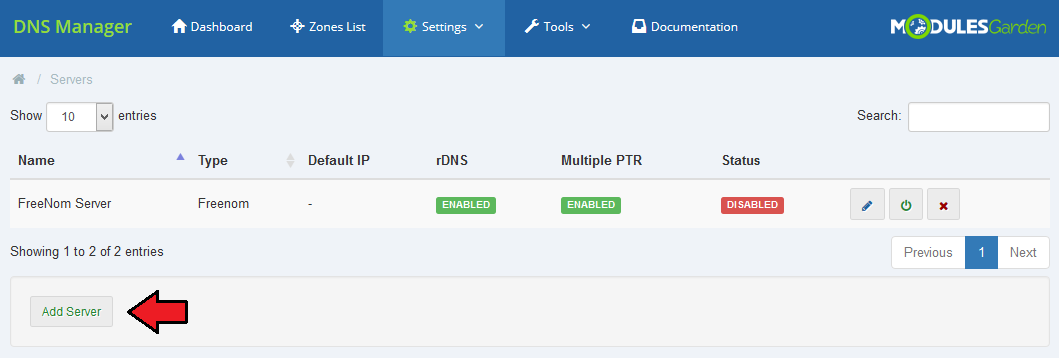
|
| To add a new server you must fill our soma data to allow connection with it. As an example, we will try to connect with cPanel server. Additionally, you may declare here whether you need rDNS, Multiple PTR or Cashe. Select the chosen options. |
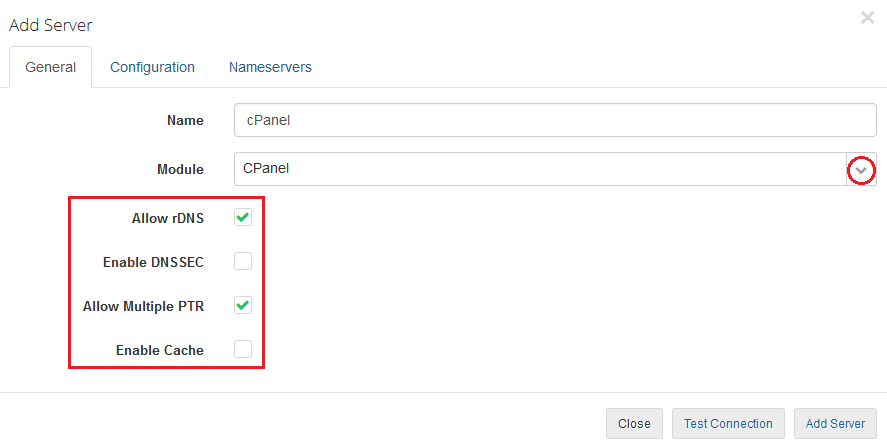
|
| Once you have chosen a server from the dropdown menu, 'Configuration' and 'Nameservers' tabs appear. Enter your username, password, Hostname/IP and any other details needed to connect successfully. Now, press 'Nameservers' and enter the nameservers that will be visible for your customers in their client area.
|
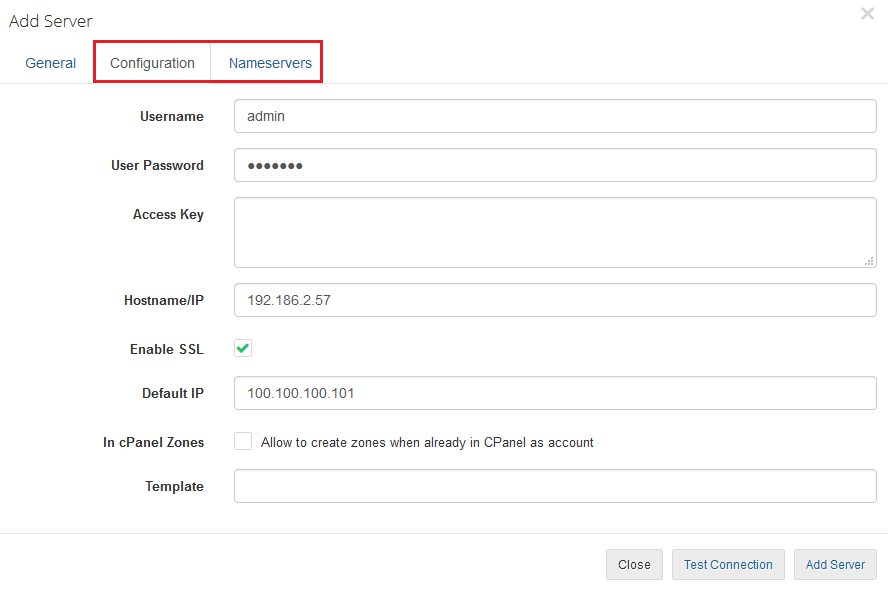
|
| Now, that you have a ready server on the list of servers you may manage it. Turn it on/off, edit or delete. |
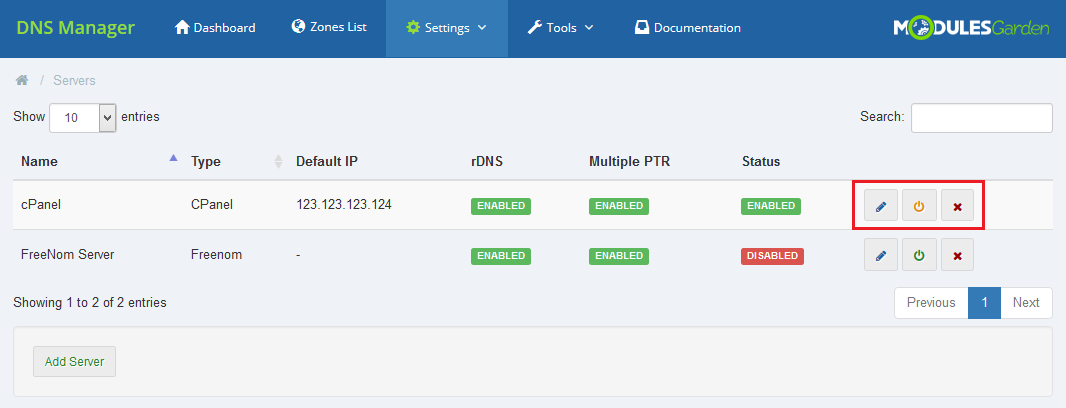
|
Management of Packages
| Packages - these are sets of products that will be sold and within which zones can be created by a client. 'Add' a new package to see how to configure it and what exactly you may specify there. |
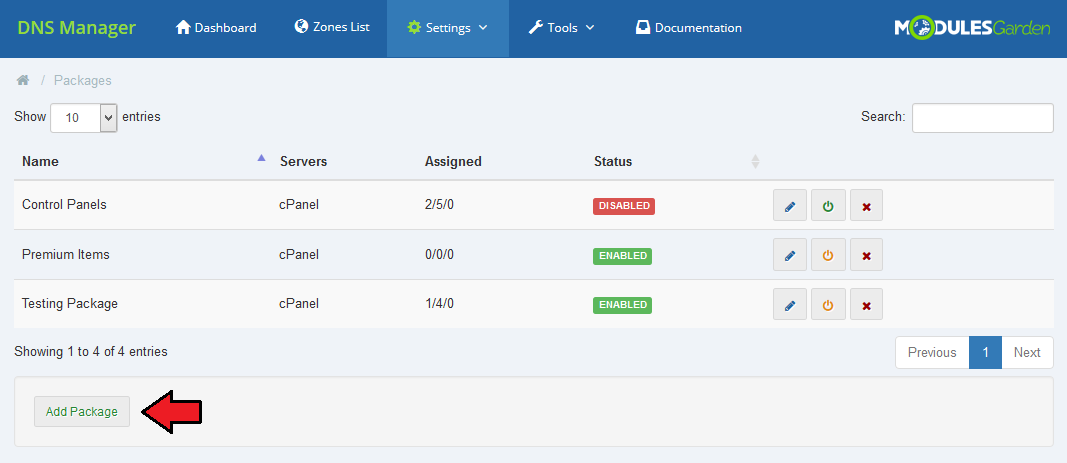
|
| In general section you must obviously name the newly created package and define the number of owned zones per item (limit of zones that a client may then create within this package). Here, you can also decide if zones should be created automatically after defined actions. These are:
|
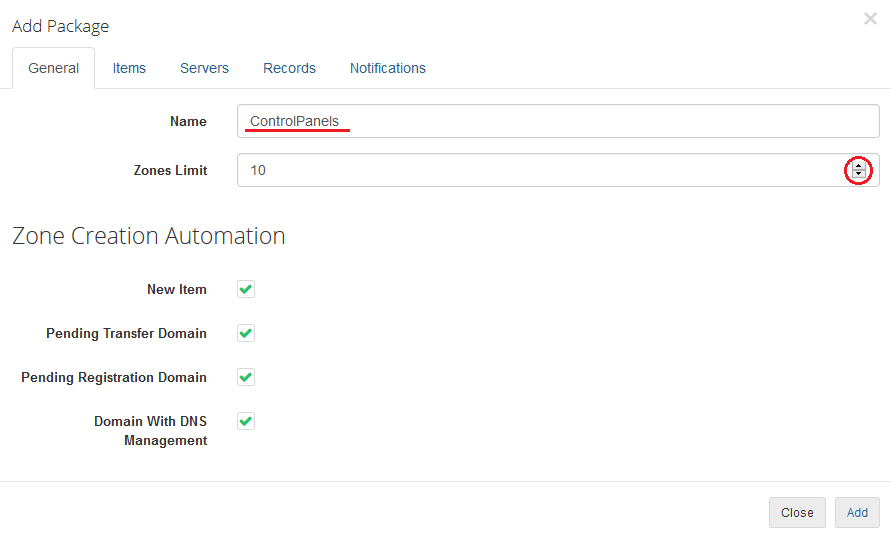
|
Items
| Assign Domains, Products or/and Product Addons from available to the package. |
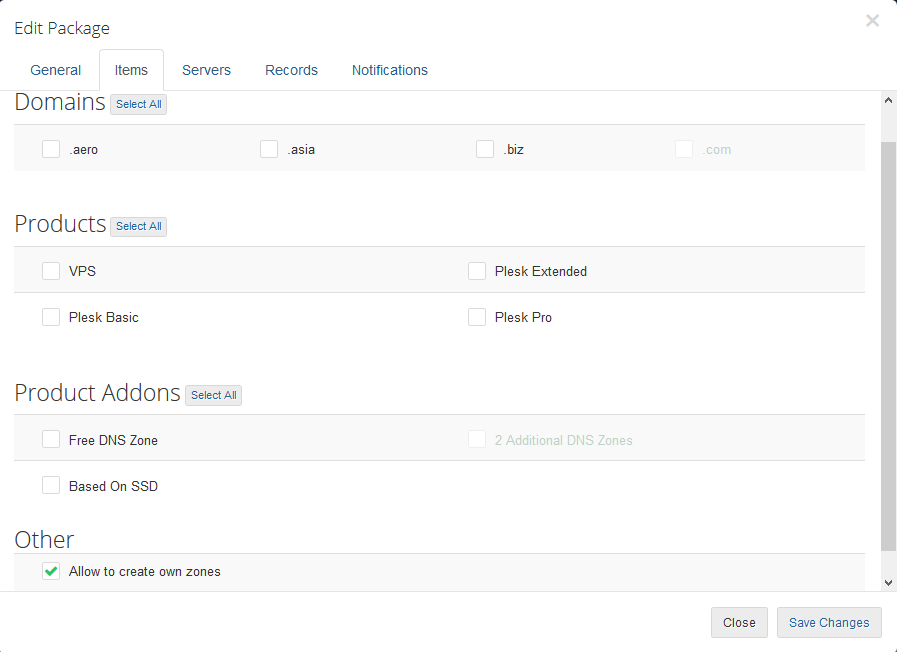
|
Servers
| Assign the package to the previously added server. Note! You may always assign the package to more than one server. |
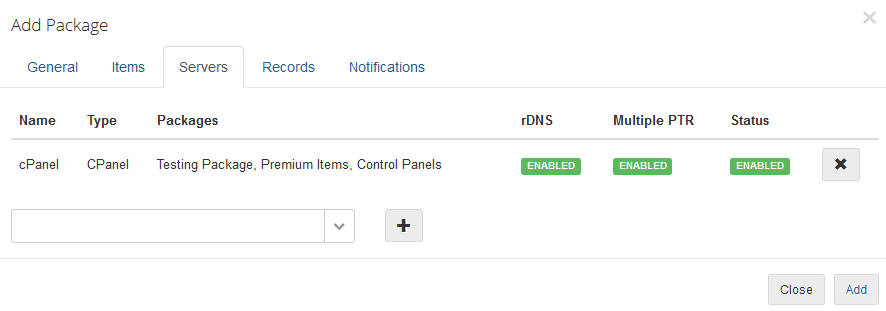
|
Record
| In this part you may define which type of records you want to allow, declare their limit and choose record sets. |
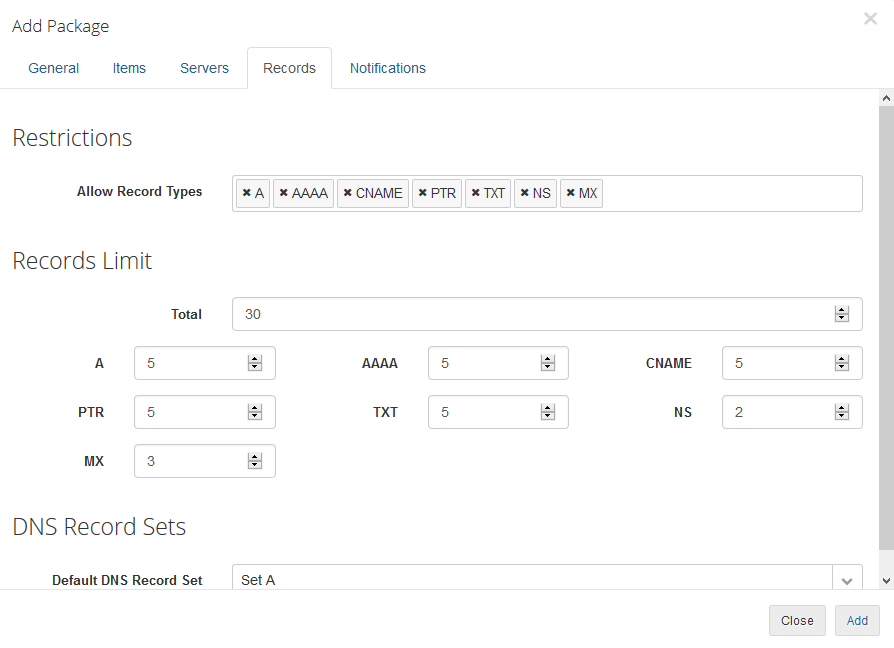
|
Notification
| In the last part you may configure which notification will be sent to clients and administrators. Do not forget to 'Add' the newly configured package. |
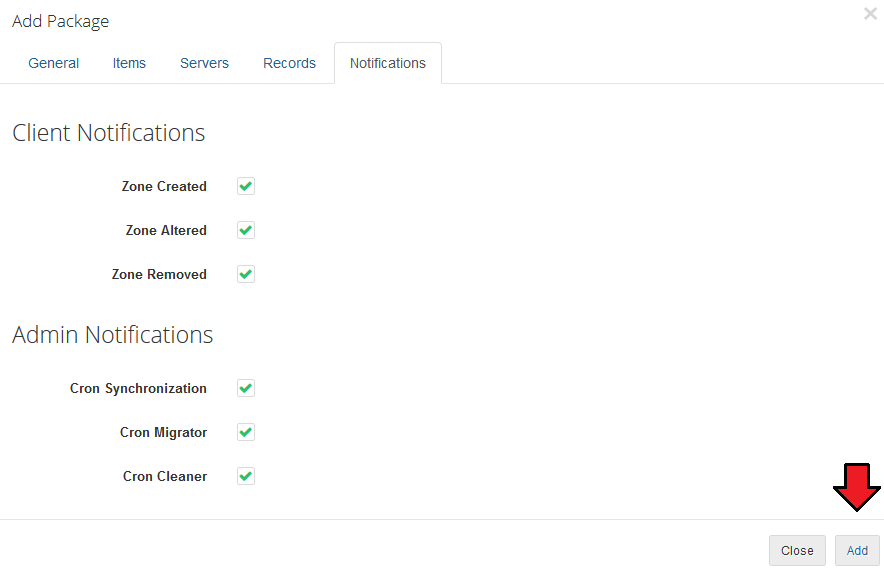
|
| Enable the newly created package to allow it to be used! |
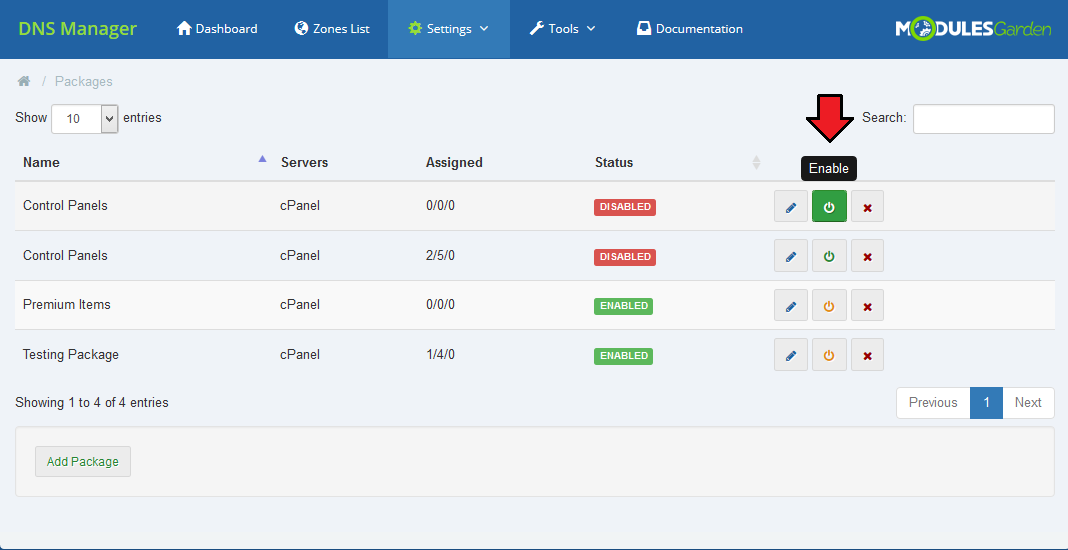
|
DNS Management in Client Area
| Now, that we already have the module configured you may see how clients will add and then manage their zones. In client area find button 'DNS Management' it will redirect you to the management page. |
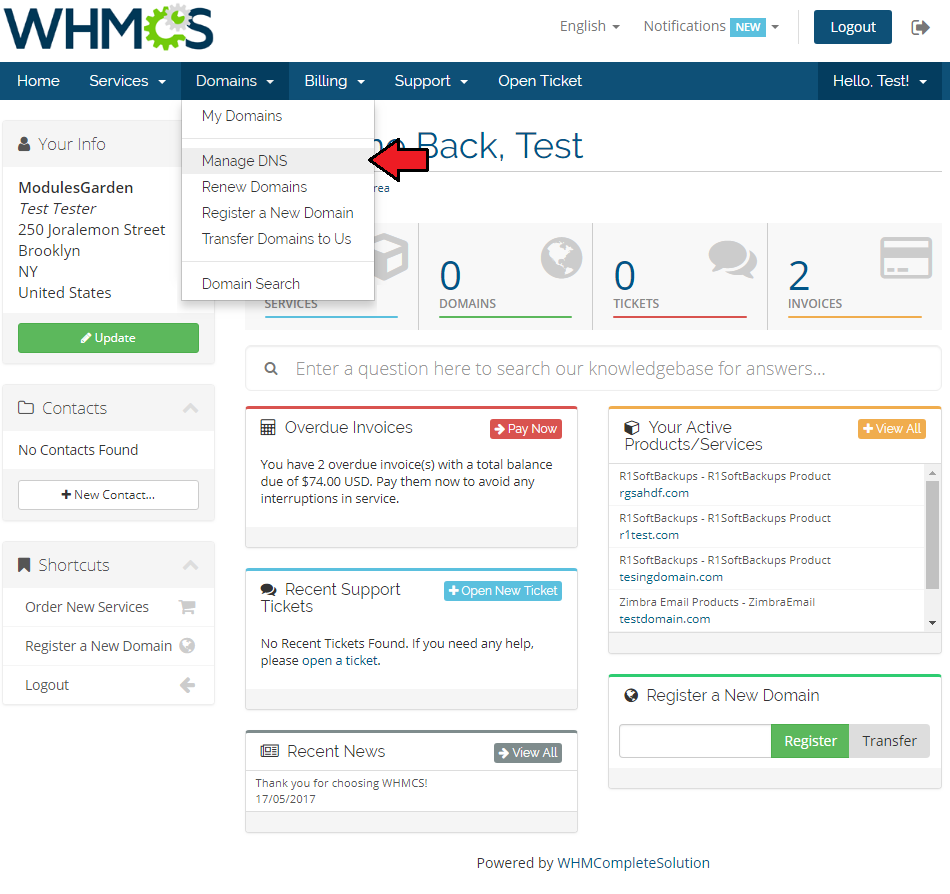
|
| In here, clients may add new zones. To do so, simply type in the name of the zone and choose IP address from the available. |
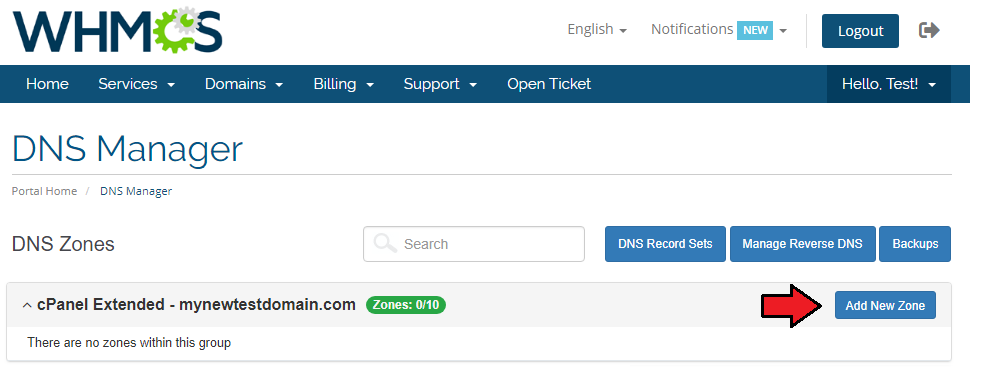
|
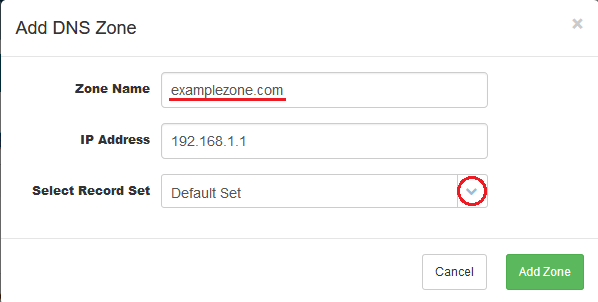
|
Allowed actions on a zone:
|
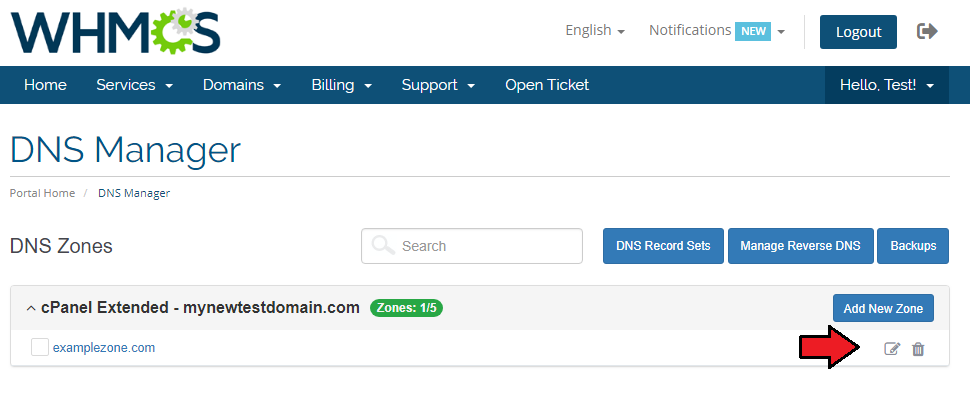
|
| Press 'Edit' to see details of the zone, you may edit the zone here and add new records if limits allow you. |
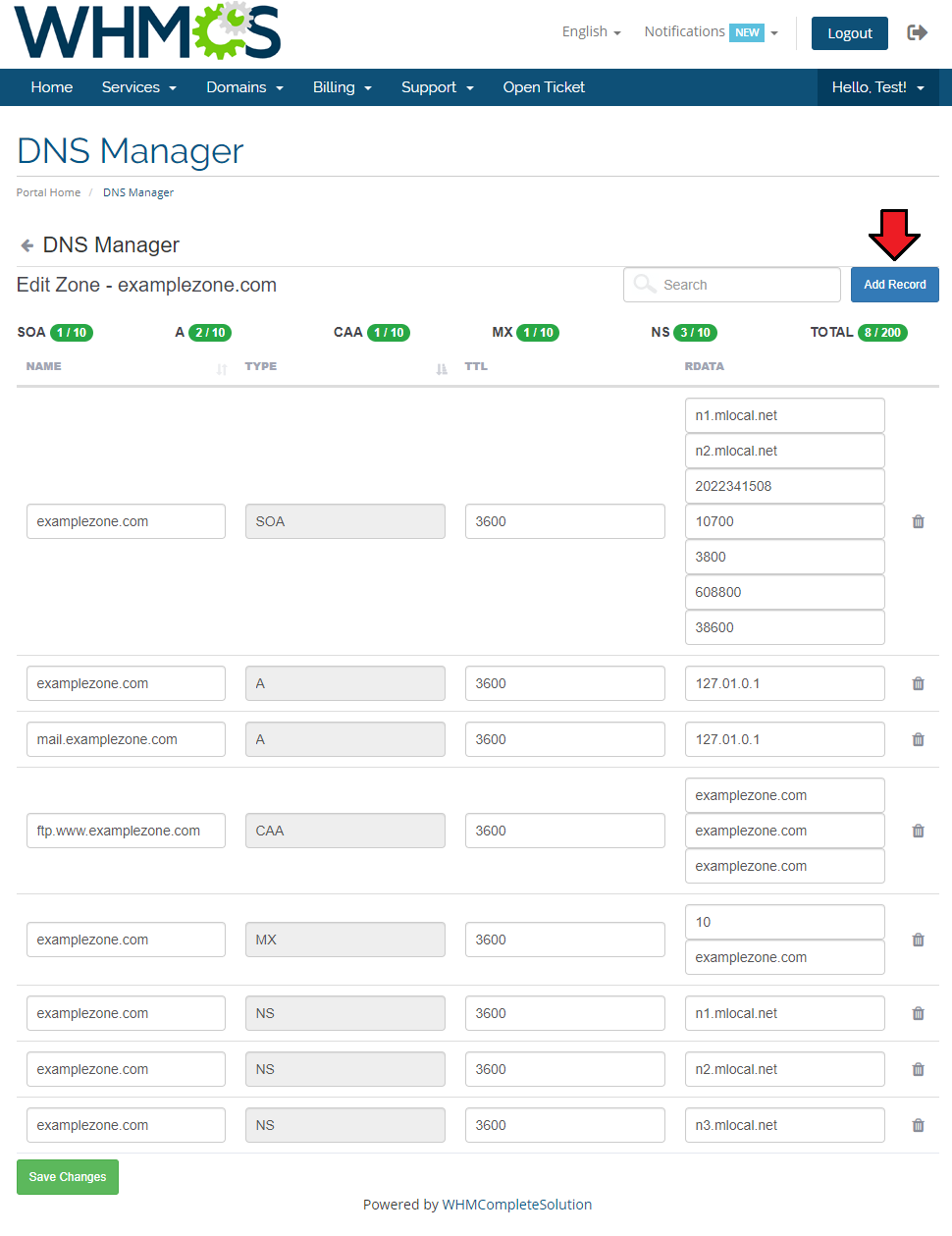
|
| Enter new record's name, choose type from available etc. |
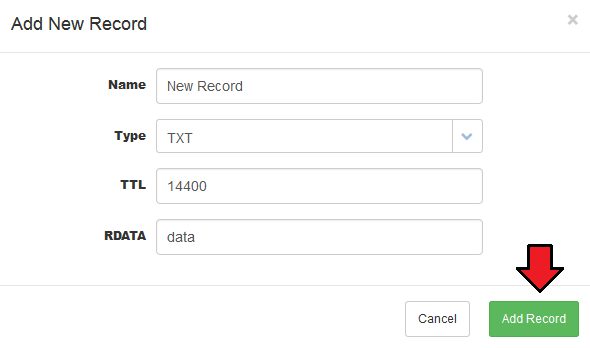
|
Zones Management
| In administrator panel, there are visible all clients' zones. As an admin, you will see whose zone it is, its type, on which server it is created and its status (created/deleted). |
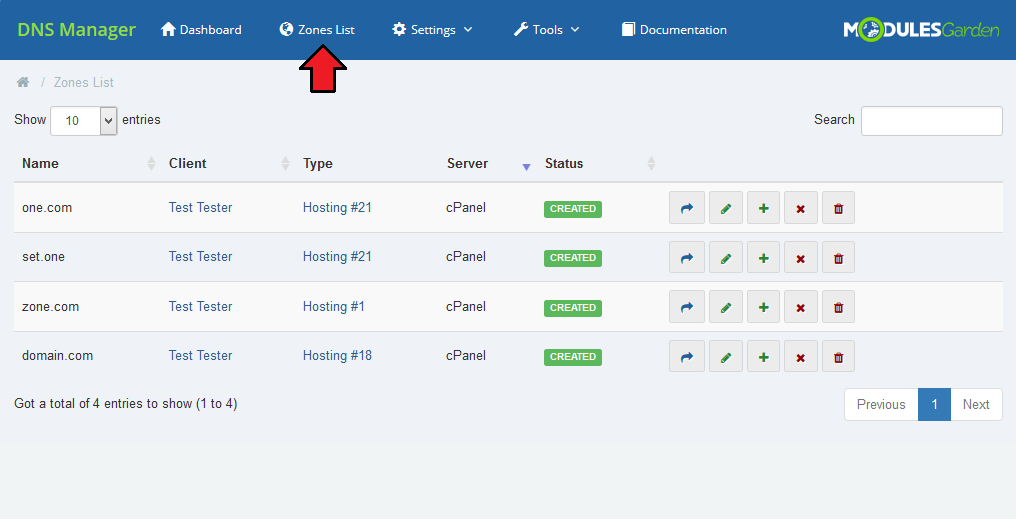
|
Actions on zones from the admin area:
|
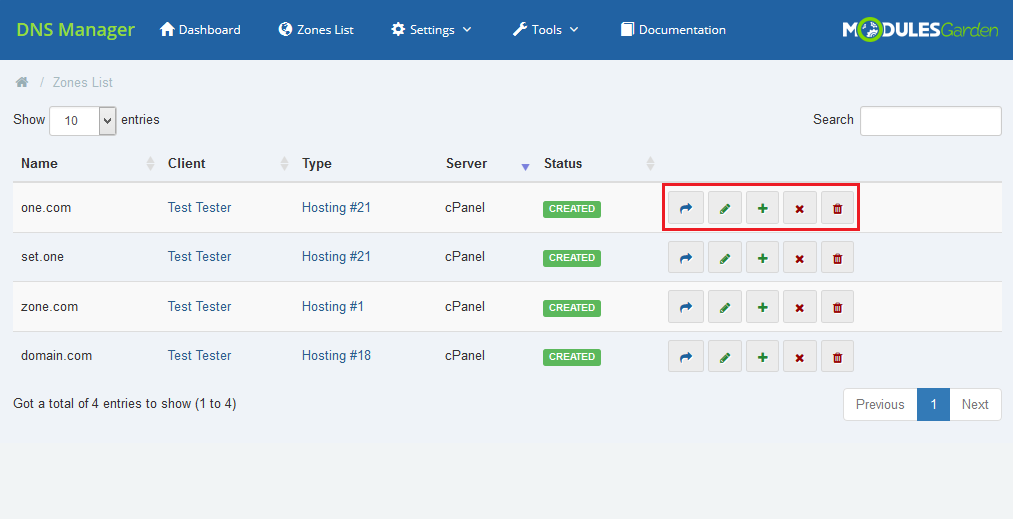
|
Additional Tools
DNS Records Sets
| Create ready made sets of DNS records. You will find them in 'Settings' → 'DNS Records Sets'. Press 'Add Set' to create a new one. |
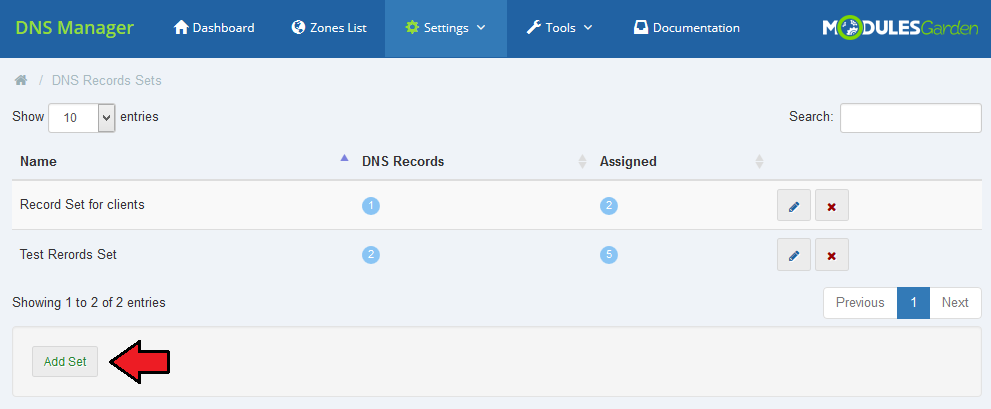
|
| Enter the newly created set name and then choose records from the dropdown menu, press '+'. |
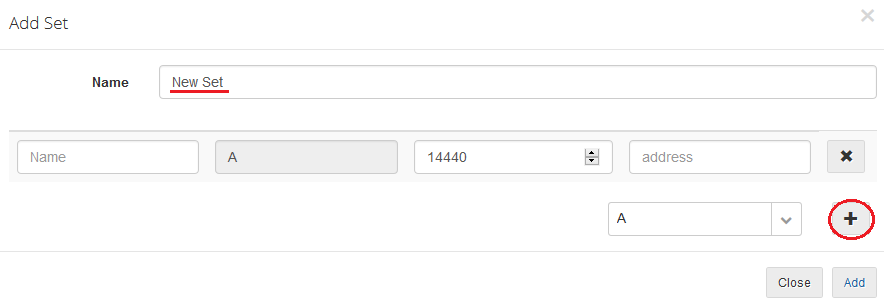
|
| Now, fill out the data as required. |
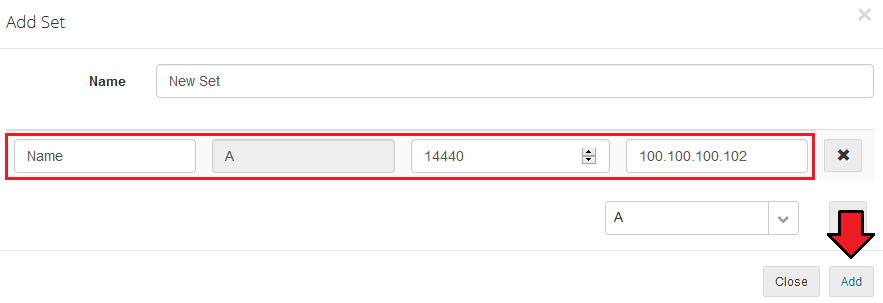
|
| Created DNS records Sets can be then used while preparing ready packages, as it was described. Ready made sets allow much faster and more personal configuration of packages. |
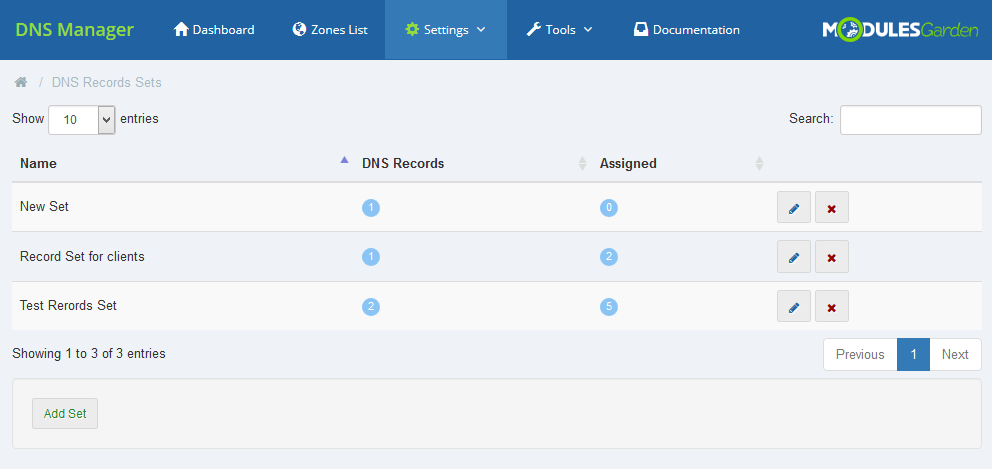
|
Global Settings
| This section has been designed to allow quick and simple configuration of global settings from one place. |
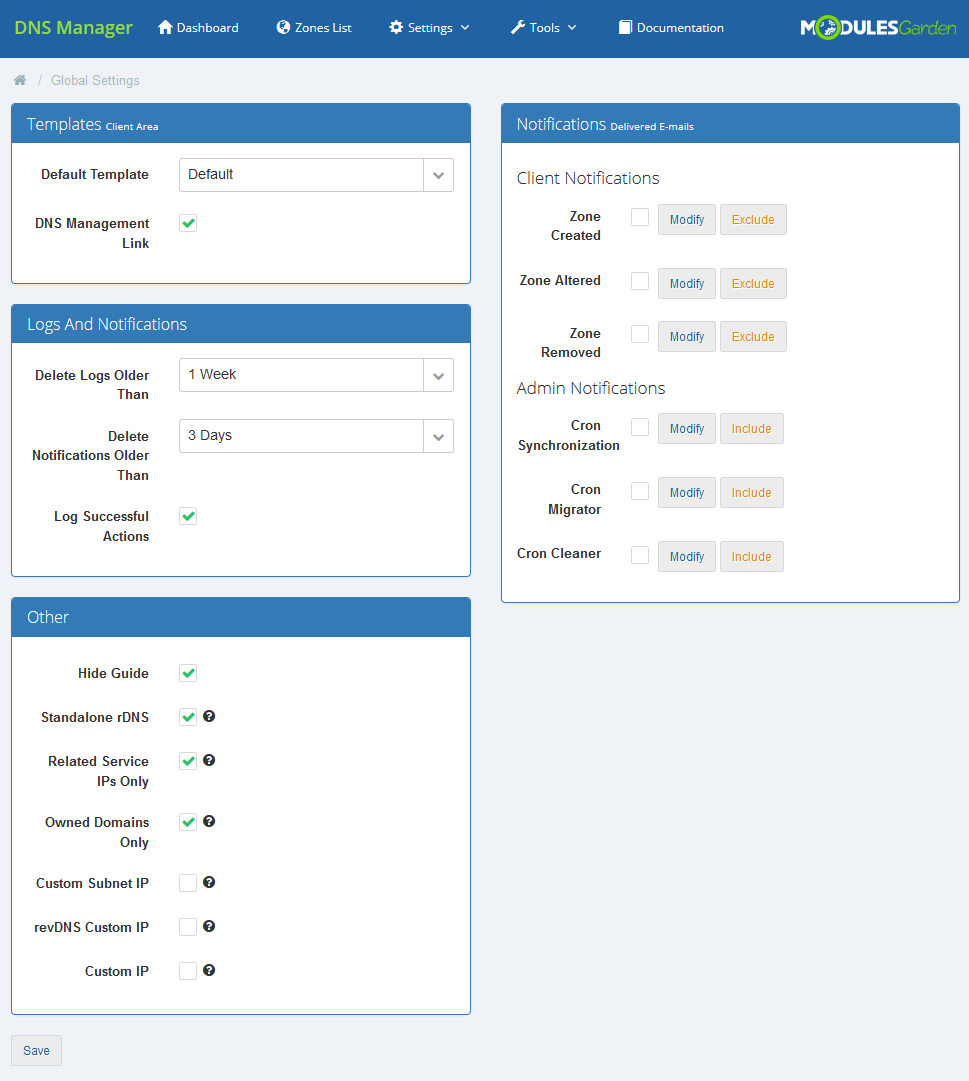
|
Templates
| Choose a default template that will be used in client area. If you have more than one template then you may allow your clients switch between them. |
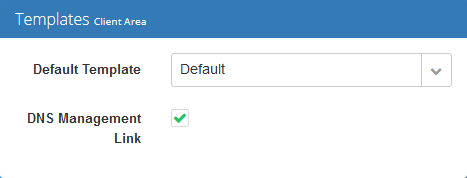
|
Notifications
| In this part, set which notification should be sent to clients and which to administrator. Select the ones that interest you. Press 'Modify' and you will be quickly redirected to the email template page where you can adjust it to your needs. |
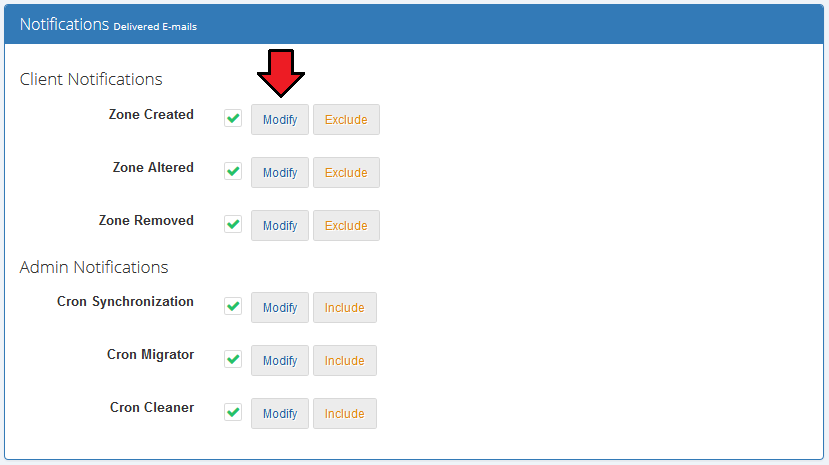
|
| Use 'Exclude' button to specify domains, products and addons that zones assigned to them will NOT be included in notifications. |
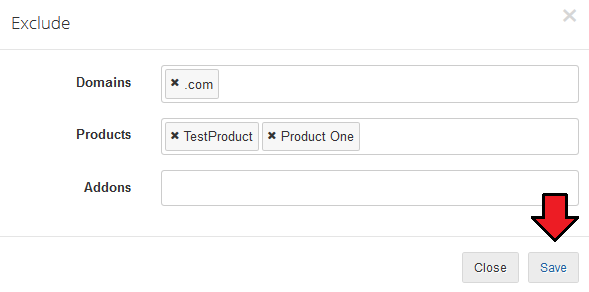
|
| Use 'Include' button to specify to which admin users notifications will be sent to. |

|
Logs And Notifications
| In this part you may impose when log entries and notifications should be removed from the system database. If you wish you may also check option 'Log Successful Actions' to store all entries in logs (DNS Manager → Settings → Logs). |
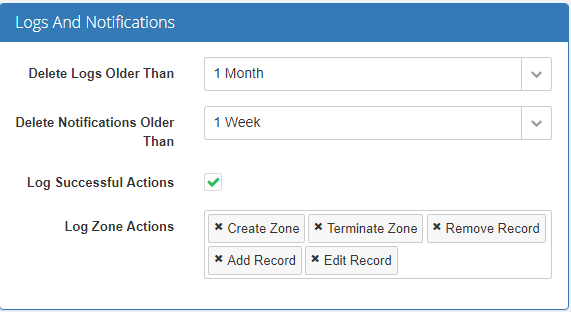
|
Cron Jobs
| In order to manage your cron job tasks proceed to 'Tools' → 'Cron'. Here, you will find four information boxes, each one responsible for management of separate cron task. These are: migration, import, synchronization and cleaner. |
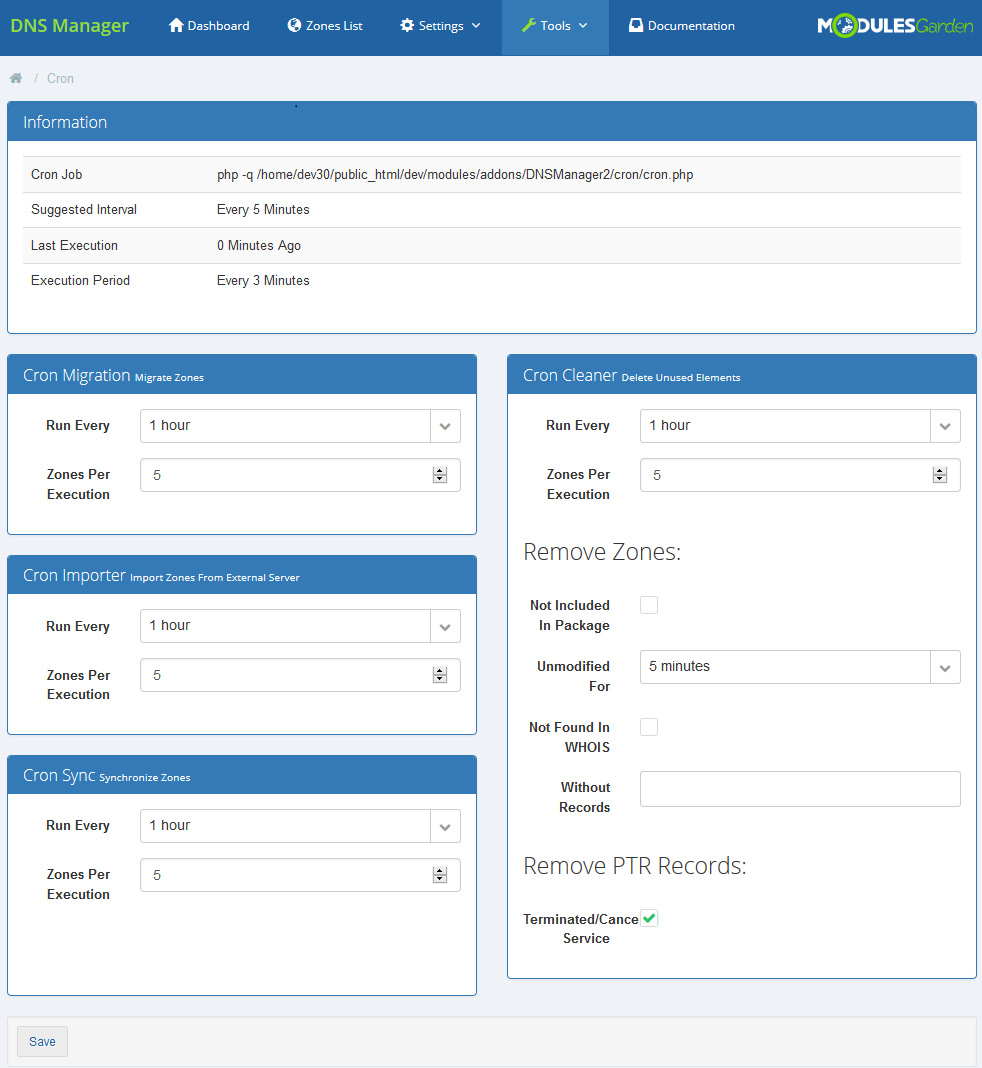
|
| At the very top, there is an info box with general cron details, such as recommended time interval of cron execution (5 minutes is suggested), the last execution time and run time period. (Keep it as frequent as possible!) |

|
| Cron Migration - responsible for calling added tasks to migrate zones between servers. Choose interval and declare how many zones can be migrated during a single execution. Cron Importer - responsible for calling added task to import zones from an external server to WHMCS. Choose interval and declare how many zones can be imported during a single execution. Cron Synchronization - this cron job is responsible for regular synchronization of created zones. Choose interval and declare how many zones can be synchronized during a single execution. Select 'Recheck Zones' to control already synchronized zones. |
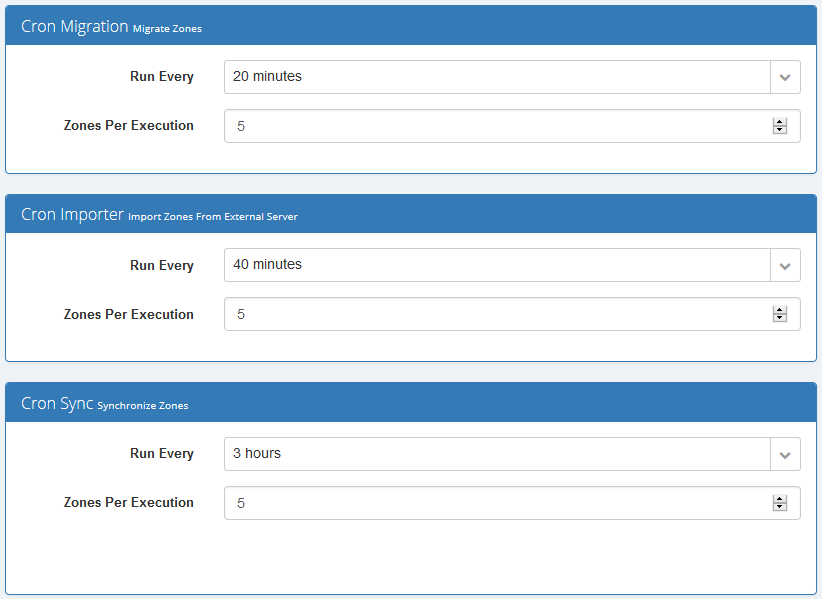
|
| Cron Cleaner - this option is a little bit more complex. Just like in case of other jobs, firstly choose interval and declare how many zones shall be cleared during a single execution. Then you may specify conditions of clearing zones and records. Zones are removed:
PTR Records are removed:
|
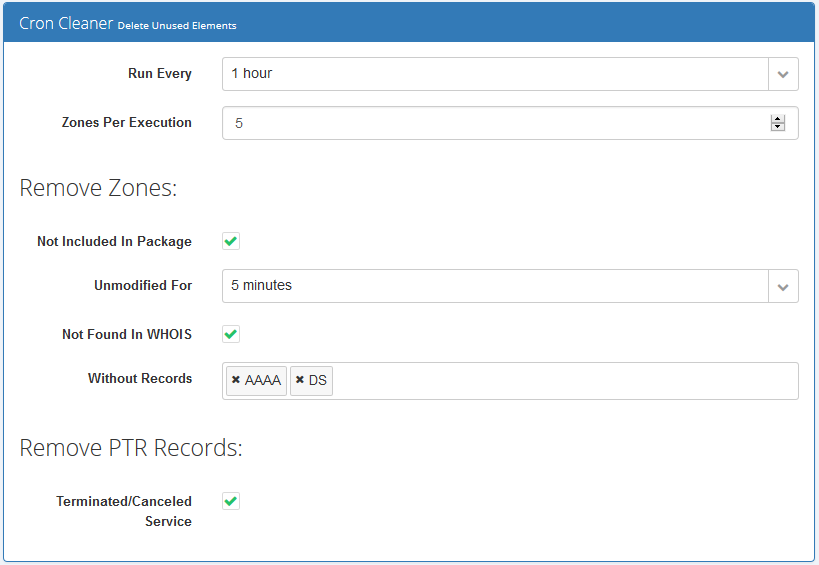
|
Import
| Import - this is an additional tool that allows import of zones that exist on outside servers to WHMCS. Move to Tools' → 'Import' in your admin panel. You will find here a list of Import assignments with information on which server they are imported from, total number of already imported zones and the number of all zones, progress of import task. |
| File:DNS2 37.png |
| To add a new import task press add 'Import' ' and choose server from which you need to import zones. |

|
| Now, when the new import task appeared on the list of awaiting imports, you may schedule the manual import, cancel the task. When already scheduled, preview the list of imported zones to assign a client and a related product to the zone. |
| File:DNS2 39.png |
| If you do not schedule the task, import will be triggered by a default cron job. |
Migration
| 'Migration' is another useful tool that you may use to manage zones efficiently. With this tool you may migrate zones between servers. Keep in mind, that when you are migrating zones from one server to another they are not imported to your WHMCS in the meantime! |
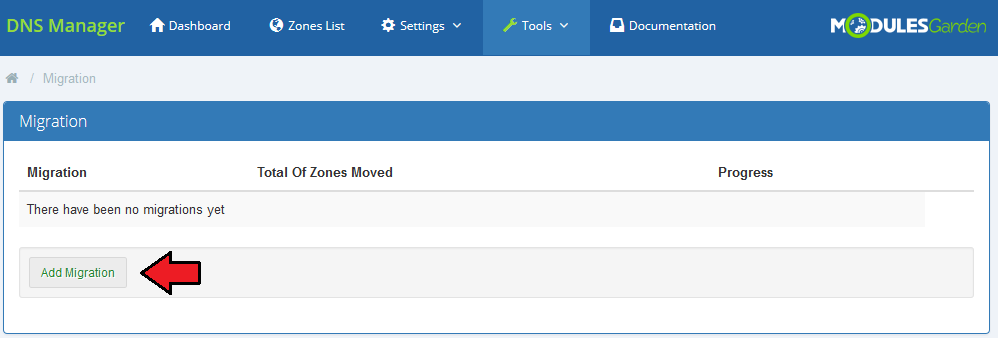
|
| To add migration task, press 'Add migration', specify from which server you wish to migrate zones, and the target server, as simple as that. Note! Migration does not copy DNS Manager settings, to illustrate: if you are migrating zones that exits in DNS Manager their locations for example are not updated. |
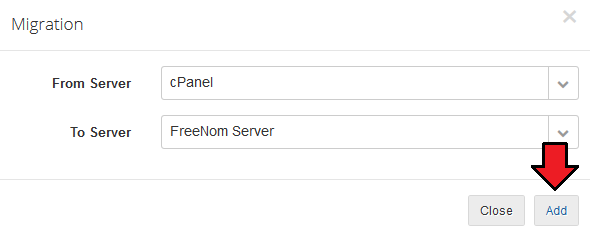
|
Tasks
| You will find a list of current tasks in 'Tools' → 'Tasks' section. Among all tasks there are import tasks, migration and synchronization tasks. |

|
| According to specifically set-up cron jobs all created tasks are regularly executed. Here, you can see current status of each task. If it is queuing for the next cron run, is currently executed, aborted or complete. Check when they were executed for the last time (Last Execution) and when the task was added. Available actions: call execution manually and remove the task. |
Dashboard
| Home page of DNS Manager which can be used to get a quick and clear preview on the crucial parts of the module: added servers with number of zones created on them, summary of email messages sent to clients and finally the most important notifications. |
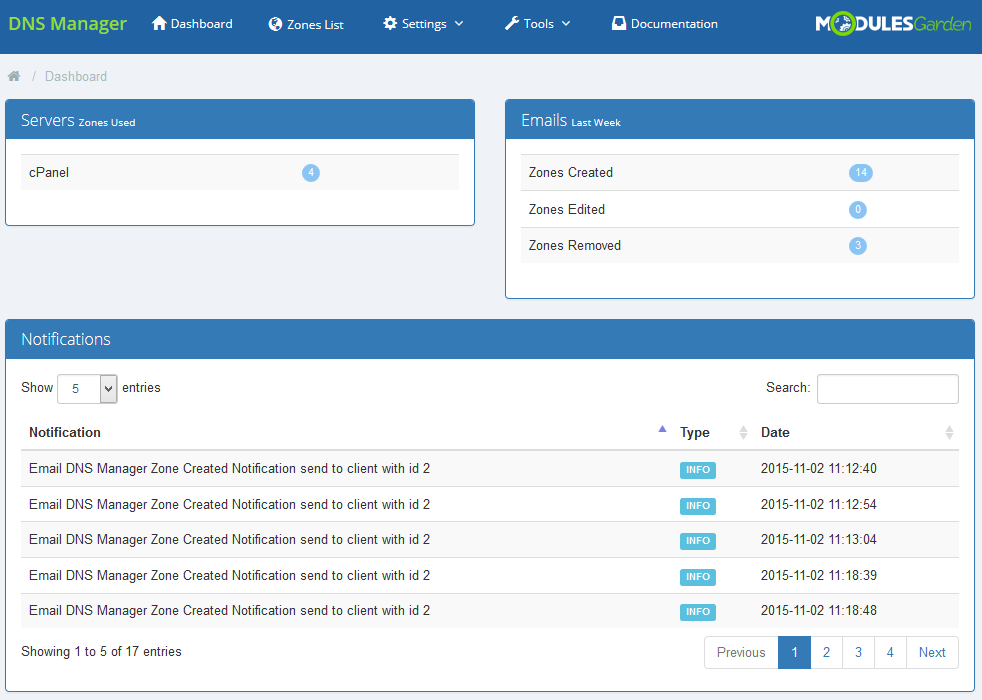
|
Custom cPanel Zone Templates
| You can allow your customers to create zones without cPanel Default Records. To do so you need to create your own Zone Template in the WHM. If you don't know how to create your own Zone Template you can follow this short guide made by cPanel: Edit Zone Templates Guide |
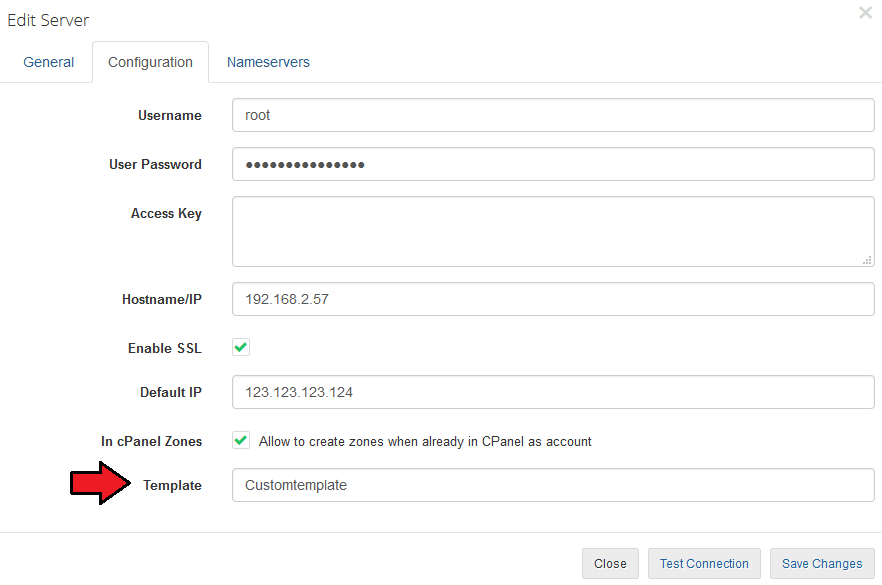
|
DNS Manager Logs
| Logs help you keep track of all the activities carried out in DNS Manager. Find them here: 'Settings' → 'Logs'. |
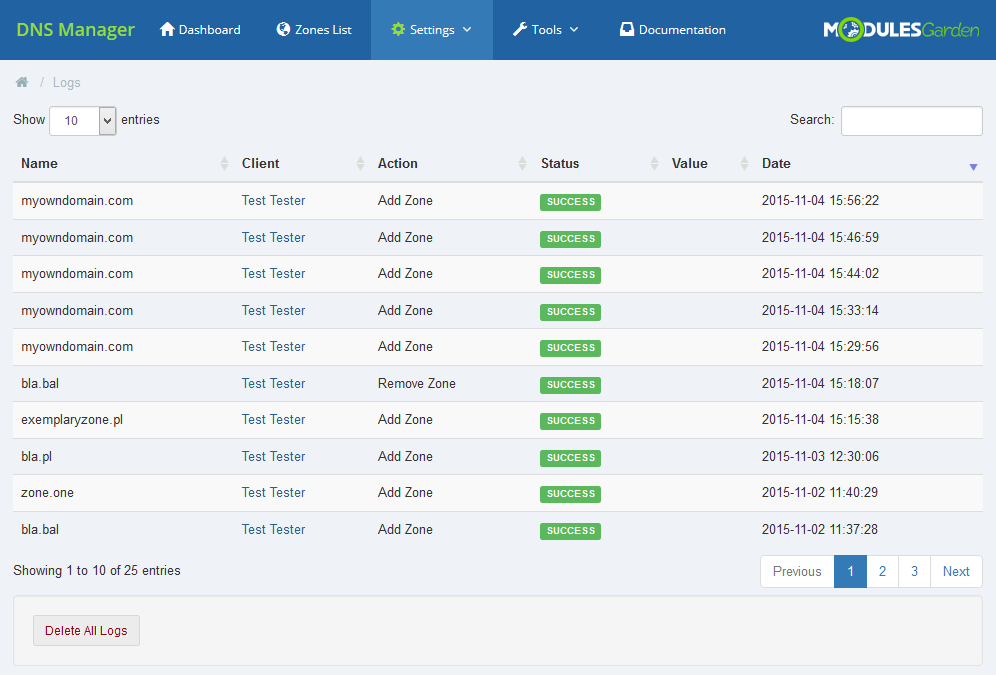
|
Tips
| 1. Keep track of your 'pending' and in 'progress' 'Tasks' to set an optimum interval time for the tasks execution. For example, set interval in the way that half of the time task is set to pending status. |
Common Problems
| 1. When you have problems with connection, check whether your SELinux or firewall does not block ports. |
| 2. jQuery 1.9 is required to work properly. |